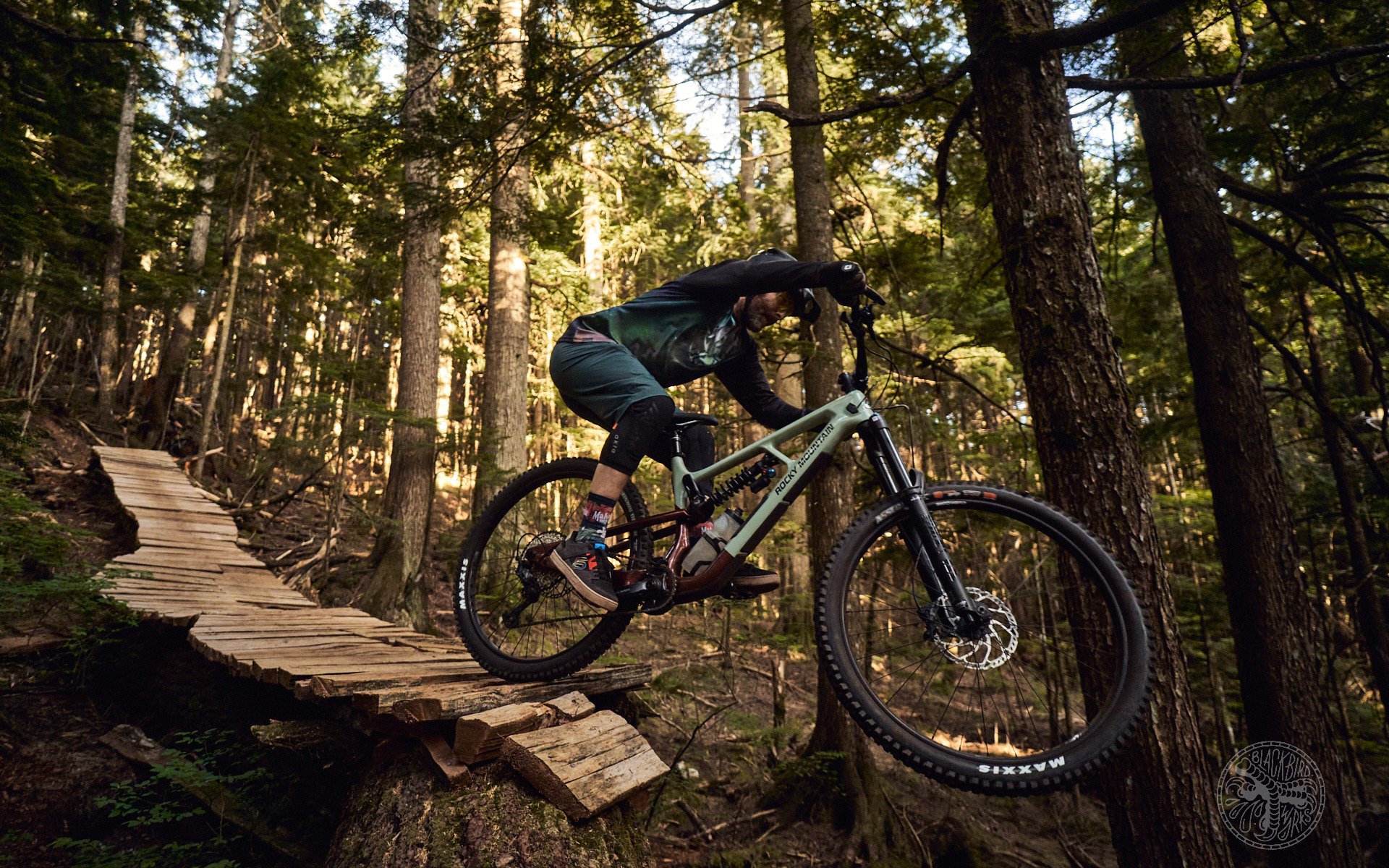
First Look
2023 Rocky Mountain Slayer
Hallowed Ground
Not that it ever went away, but the Slayer is back - bigger, meaner and sharper than ever, and it’s packing new weapons up its villainous sleeves. It’s no secret that Rocky Mountain has some very deep roots here on the North Shore, and for a brand whose history is steeped in freeride, it doesn’t get any more freeride than the Slayer.
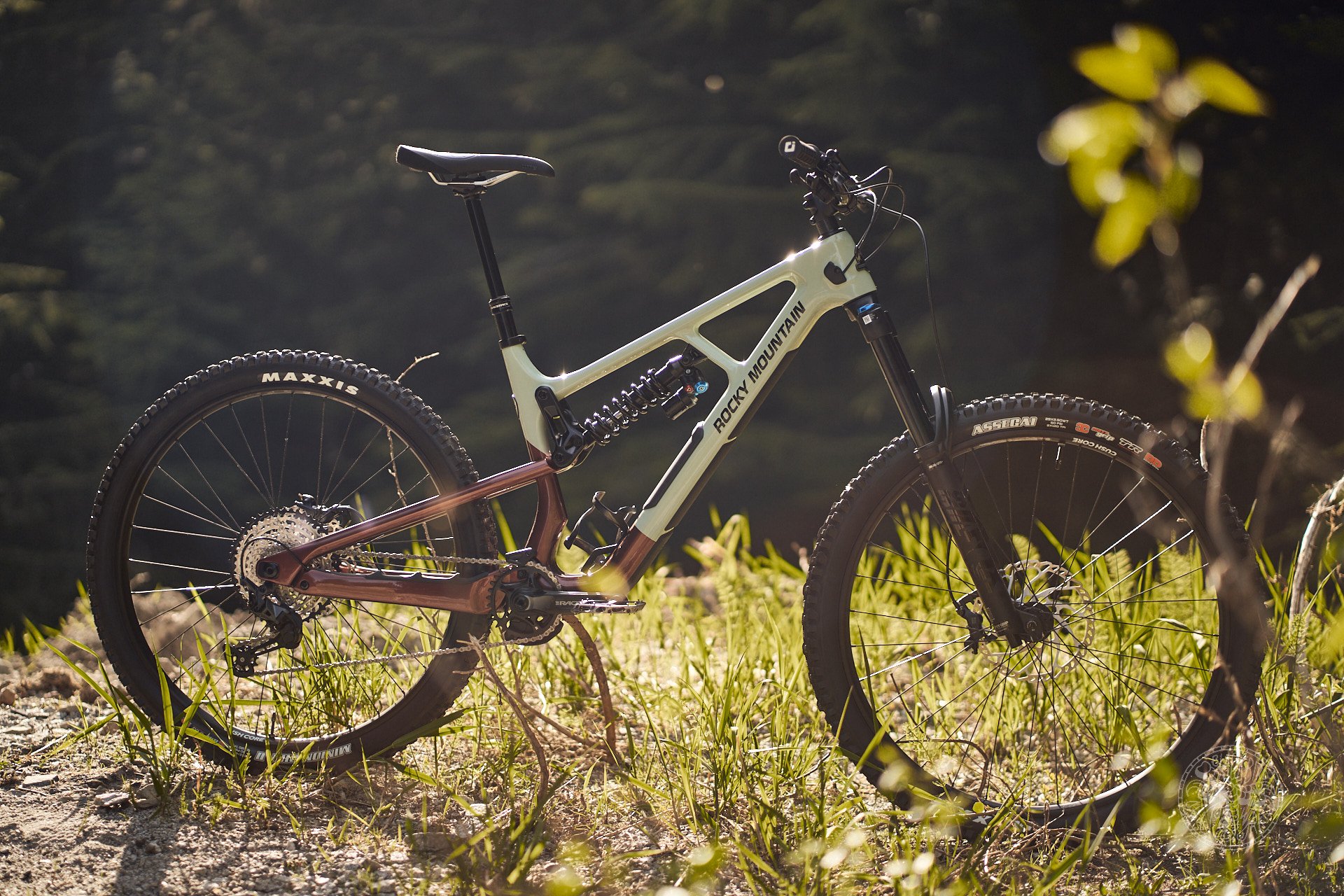
Classic Rocky Mountain lines, and oh, that colour! The new Slayer is a beautiful beast.
First introduced in 2001, the Slayer has always been geared towards progressive riding and pushing limits on what was possible on a mountain bike. When the Maiden DH frame was put out to pasture in 2020, the Slayer became Rocky Mountain’s flagship of gravity, providing a common platform for freeriders, bike parkers and sometimes racers.
The Slayer saw its last update in model year 2020, and I remember vividly those distinctive red and black bikes popping up just as the world began shutting down and hoarding toilet paper. What a ride that was! For 2023, the Slayer gets the longer, lower, slacker treatment across the size range, while small and medium sizes now come mullet-wheeled as standard. Large and XL bikes roll on two 29" wheels, but are mullet-compatible. Likewise, small and medium bikes can be set up full 29er. Going from 29er to mullet (or vice versa) requires swapping out the shock link.
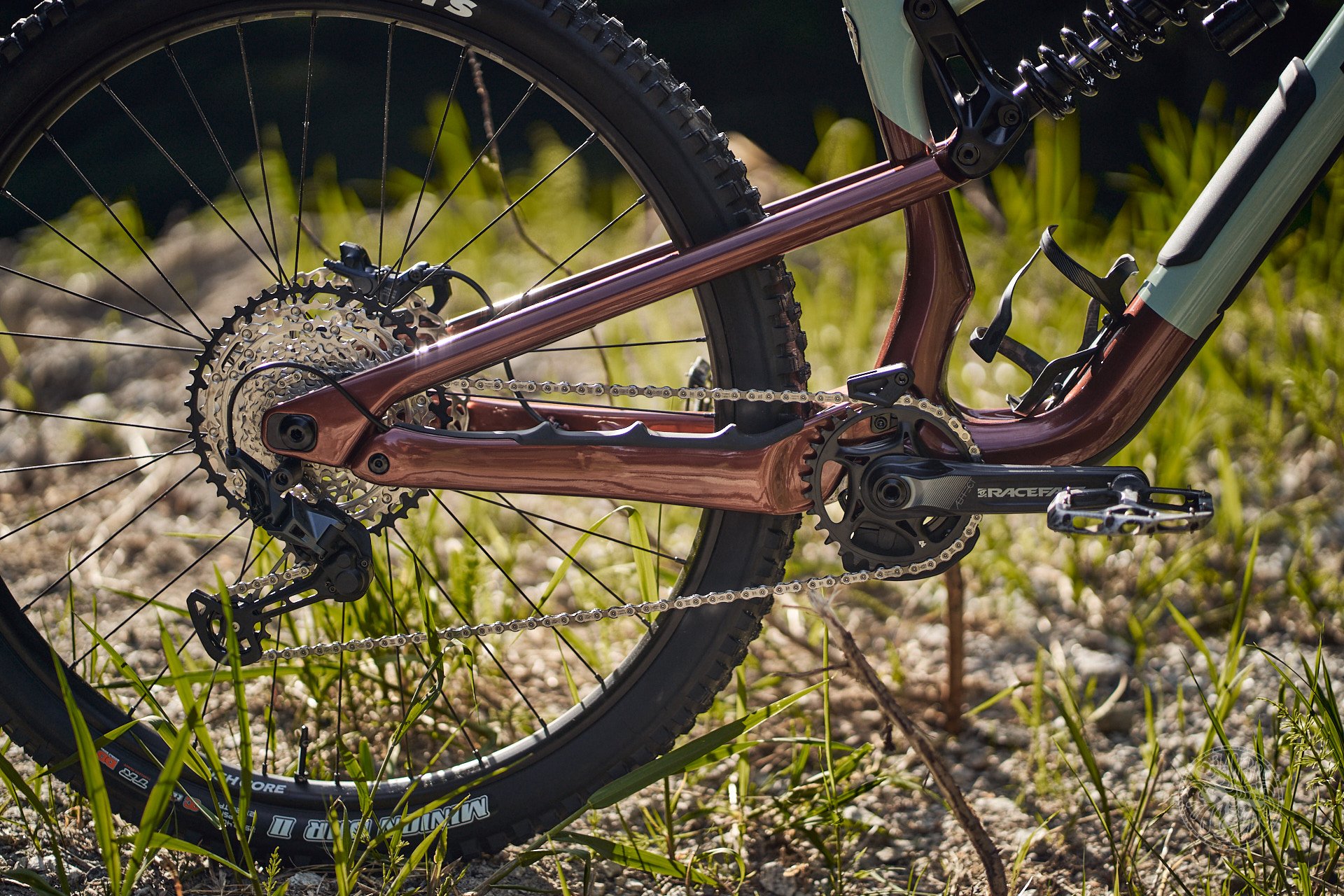
New for 2023 are carbon fiber seat and chainstays.
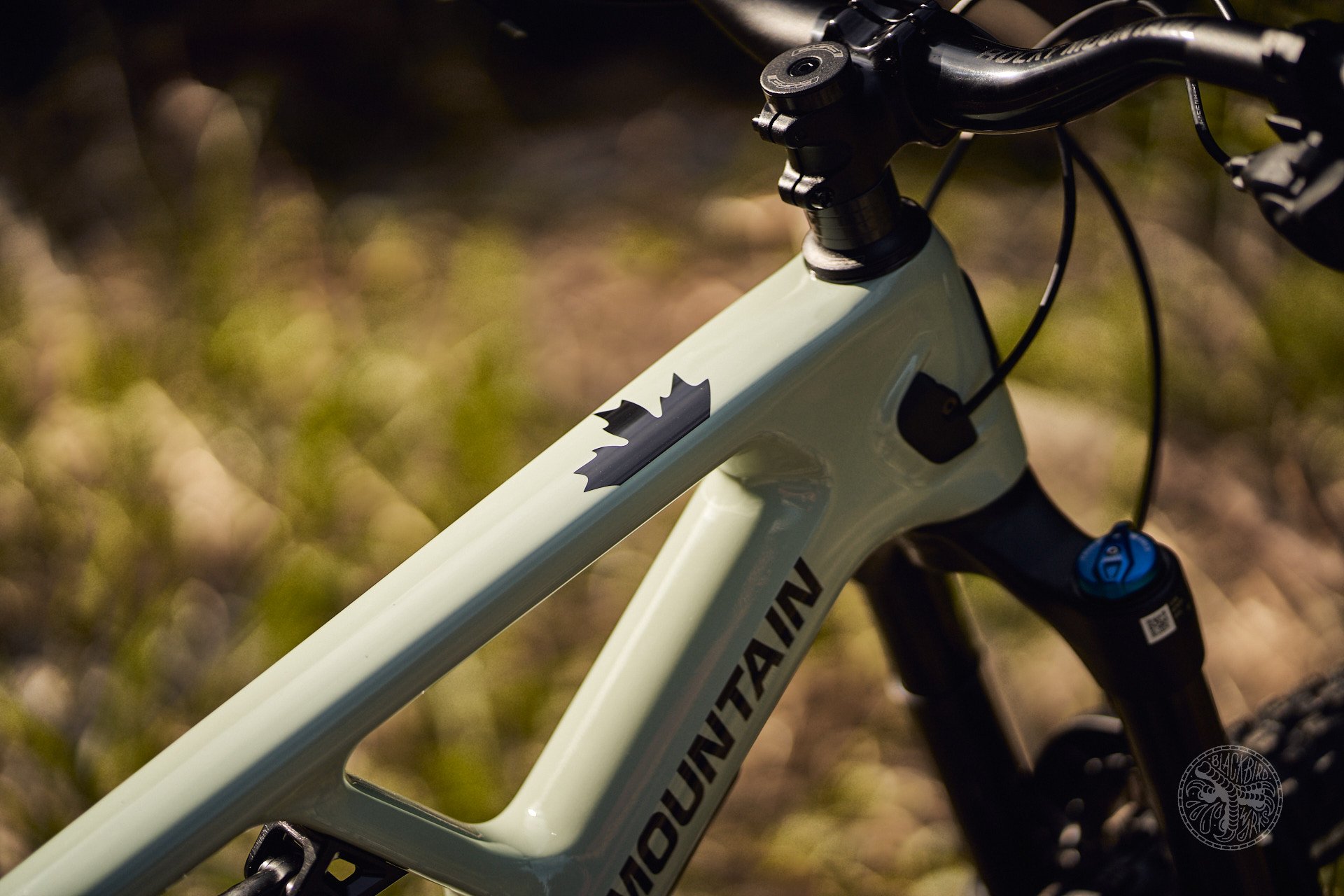
Internally guided cable routing. Your mechanic will thank you.
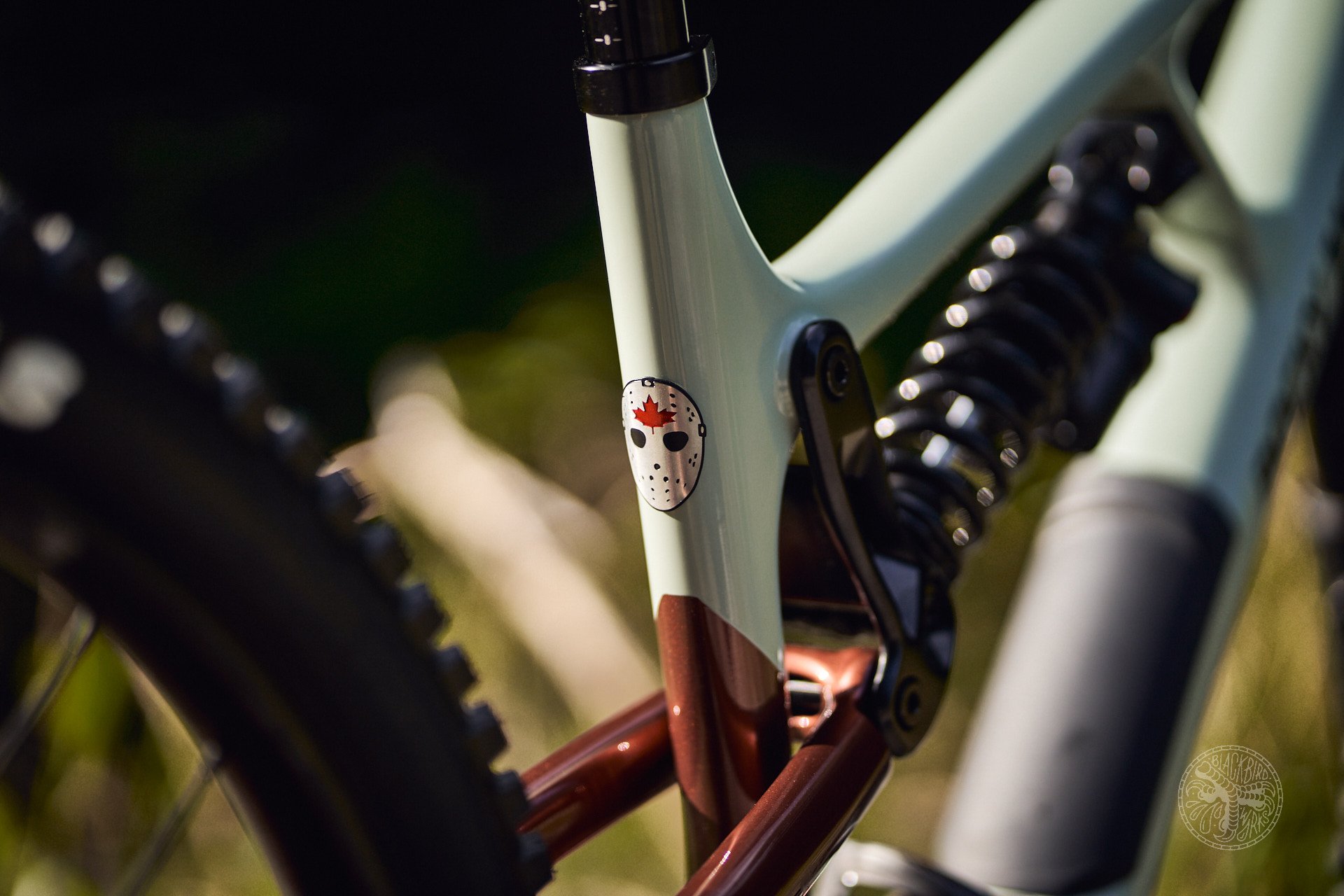
Does your bike have a tail badge?
Also new for 2023 is the full carbon frameset now found on all Slayer Carbon models - no more alloy stays bolted to carbon front ends. The previous Slayer, with its beefy alloy stays, was known to be a bit on the heavy side, so the full carbon construction helps trim some grams. Our size large Carbon 50 test bike weighs in at just under 38 pounds - fairly respectable considering the build. If carbon ain’t your bag, fear not - the Slayer is available in a few alloy versions as well, including a dual crown-equipped park bike. All models feature 180mm travel at both ends, except for the park bike which gets a 200mm Boxxer.
Rocky Mountain bikes are known for being among the most adjustable bikes on the market, and the Slayer is no different. I mean, it’s no Geometron, but with the inclusion of Rocky’s Ride-4 linkage chip and adjustable chainstay length, plenty of geometry options are available. From low, slack and long to lower, slacker and longer, the Slayer has you covered. And if a 63.3° head tube angle isn’t slack enough for you, don’t worry - that’s the steepest setting. Reach and seat tube angles have also been modernized from the previous Slayer, although they aren’t pushing the envelope quite like the head tube angle is. While the chainstay length is adjustable from 439mm to 449mm, there is no variation in length from the small to XL sizes.
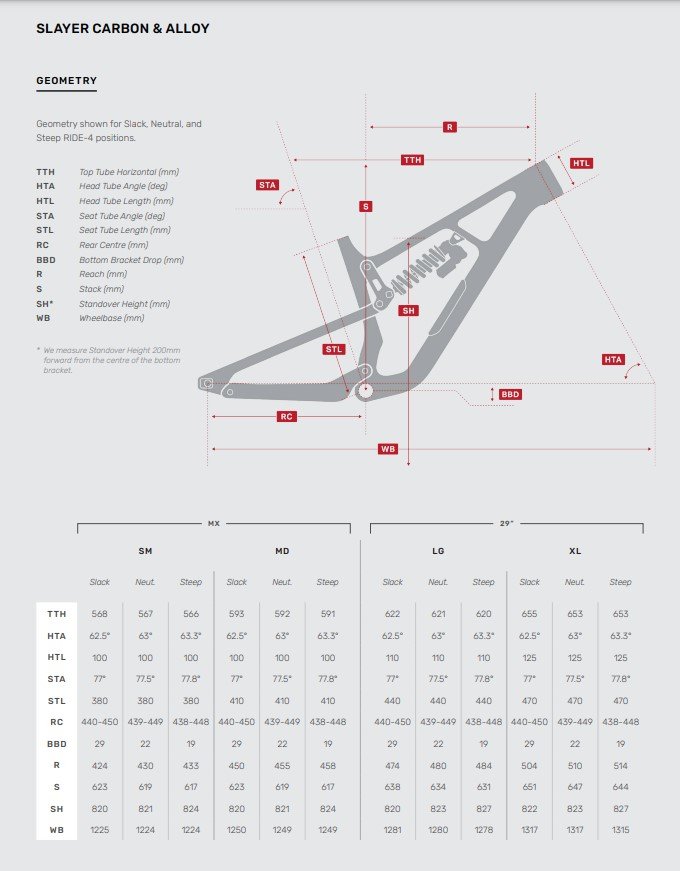
The PenaltyBox
This new Slayer also marks Rocky Mountain’s first foray into the world of in-frame storage. The PenaltyBox is Rocky’s take on this indispensable feature, and they’re doing it a little differently than everyone else. Rather than bolting the water bottle cage to the access door, Rocky decided to separate the door and bottle mount entirely, with the access door located just above the cage mount. The PenaltyBox door clips into place with a trick magnetic latch. Very cool stuff, but only available on the carbon models. I’m a huge fan of in-frame storage, and it’s a feature that I just don’t want to live without anymore. Can we draw a line in the sand and just agree that any major bike manufacturer not offering some kind of in-frame storage as of 2024 should be shamed and ridiculed into doing so? There are only so many clever, G-rated “box” monikers to go around, so get on it!
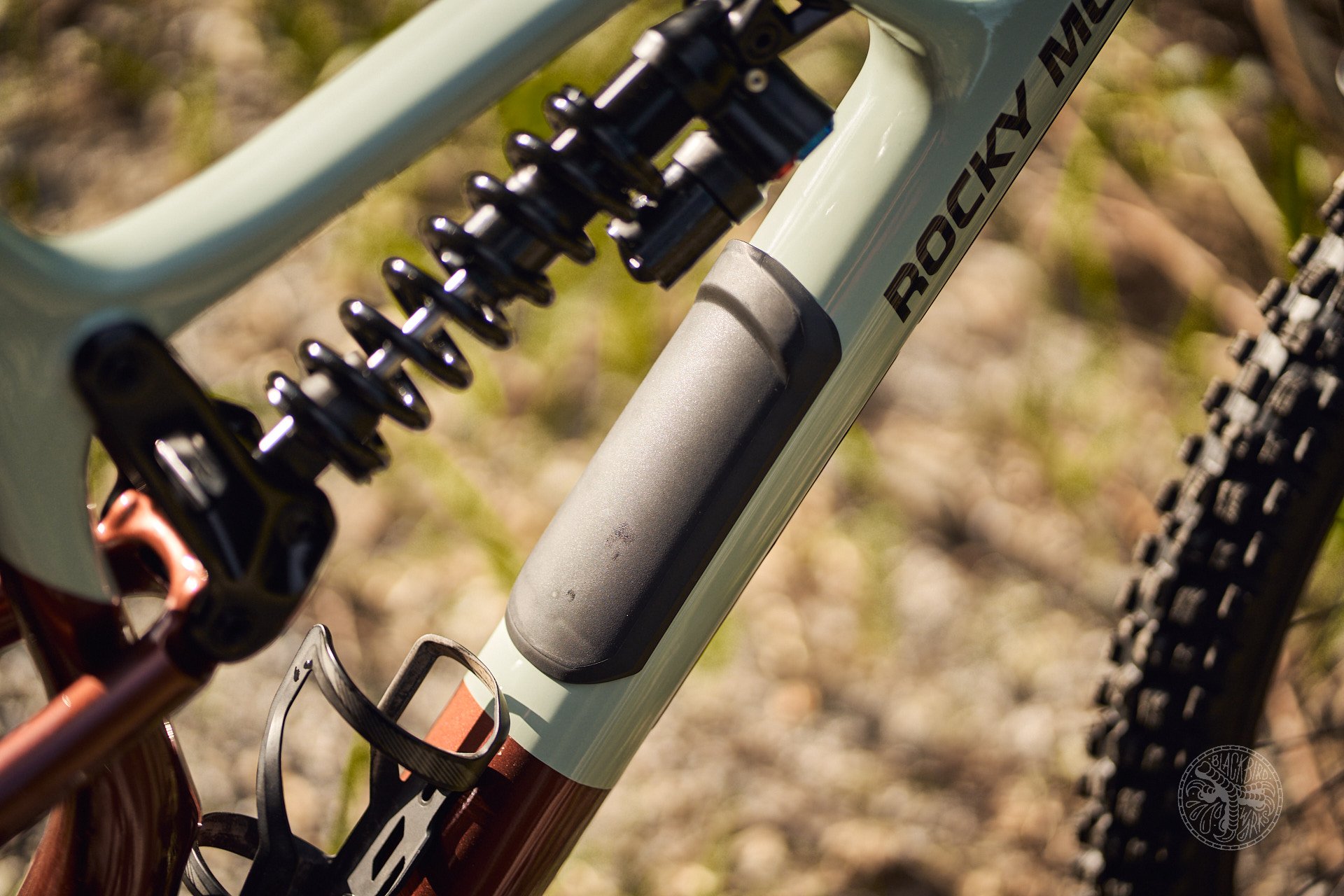
The PenaltyBox just might be the cleanest looking storage solution around.
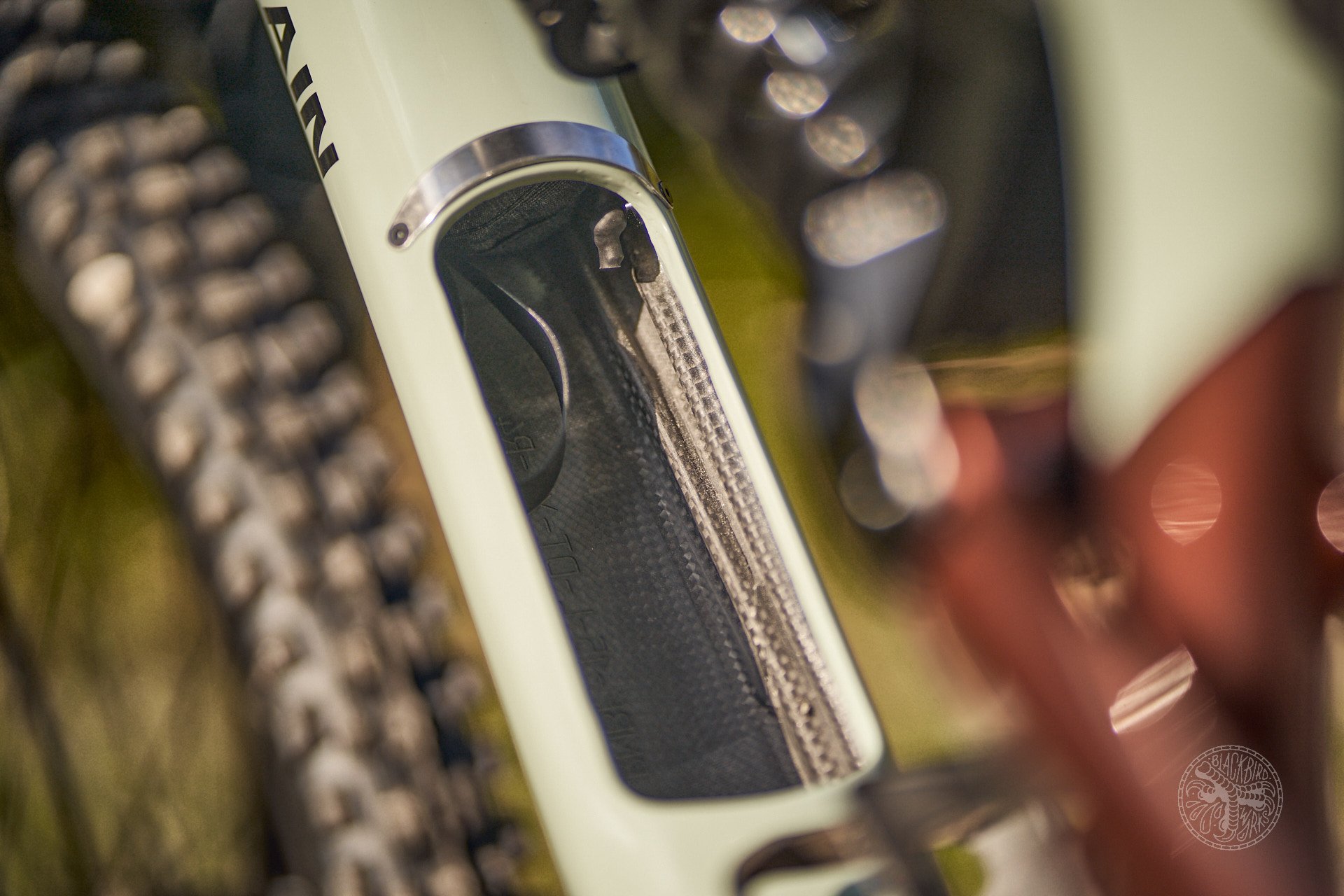
The access door is secured with a magnetic latch.

One of the two fabric pouches Rocky includes for your storables.
Slayer Carbon Builds
At the top of the heap lies the Slayer Carbon 90, adorned with Fox Factory suspension, Shimano XTR everything, and a Race Face ARC Carbon 31 wheelset. Stepping down a rung is the somewhat less eye-watering Carbon 70, which comes with a bit less carbon, a lot less Kashima, and is a mostly Shimano XT affair. Next in line we have the Carbon 50, which is the trim I will be reviewing over the next few months. The 50 comes equipped with SLX brakes and drivetrain, WTB ST i30 rims, and a smattering of Race Face Aeffect and Rocky house brand bits and pieces. Suspension duties are handled by a Fox 38 Performance Series fork, which includes the basic GRIP damper, while the rear end sports a DHX2 Performance Elite coil shock. I self-identify as a suspension snob, and among my list of first world problems, it’s not very often that my bicycle suspension doesn’t say “Ultimate” or “Factory” somewhere on the wrapper. I’d like to think my snobbery is well-earned though, as excellent suspension has literally saved my ass from catastrophe on many occasions. That said, I’m looking forward to finding out where the ragged edge lies for this “Performance” level bounce from Fox.
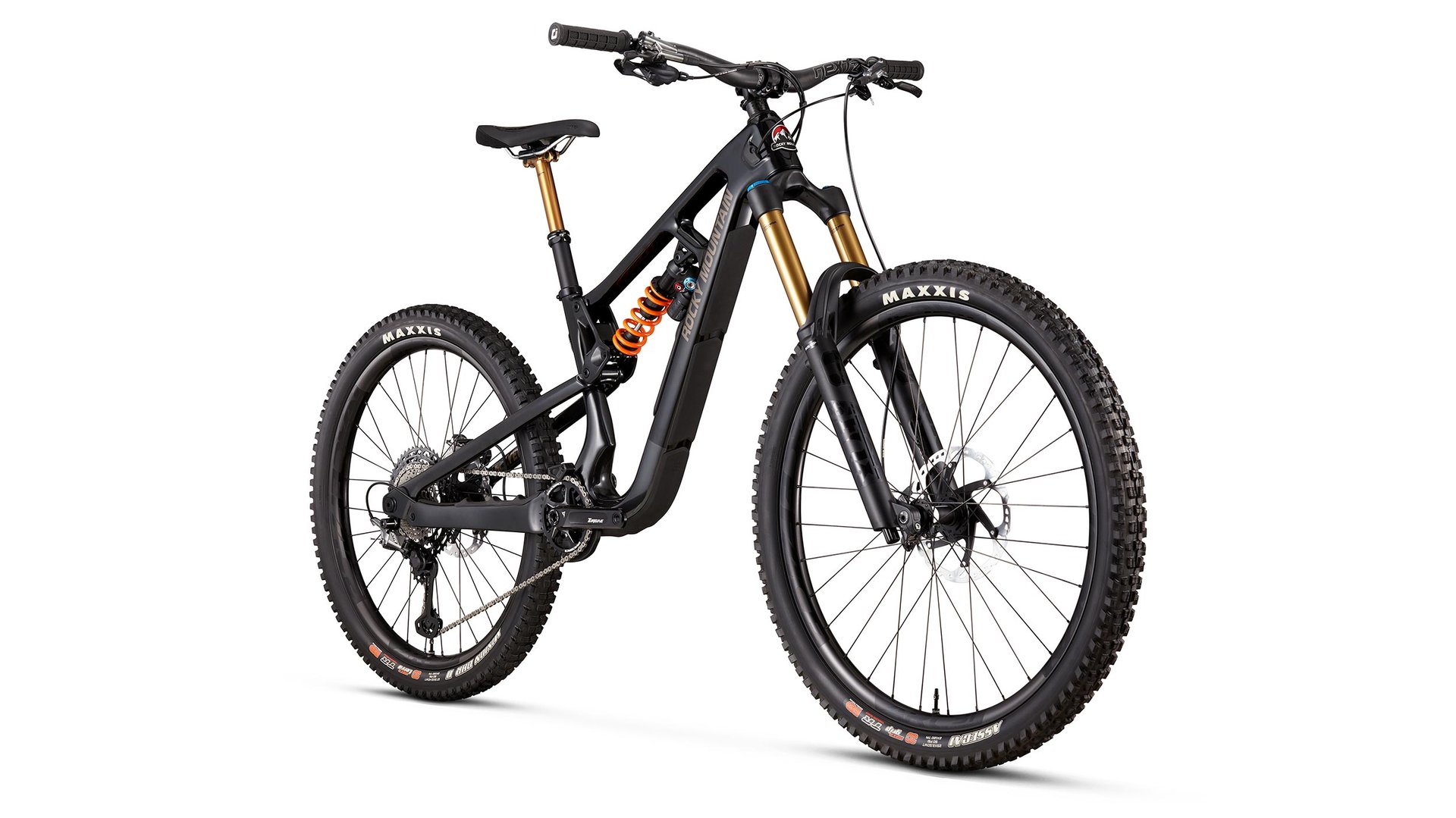
Slayer Carbon 90
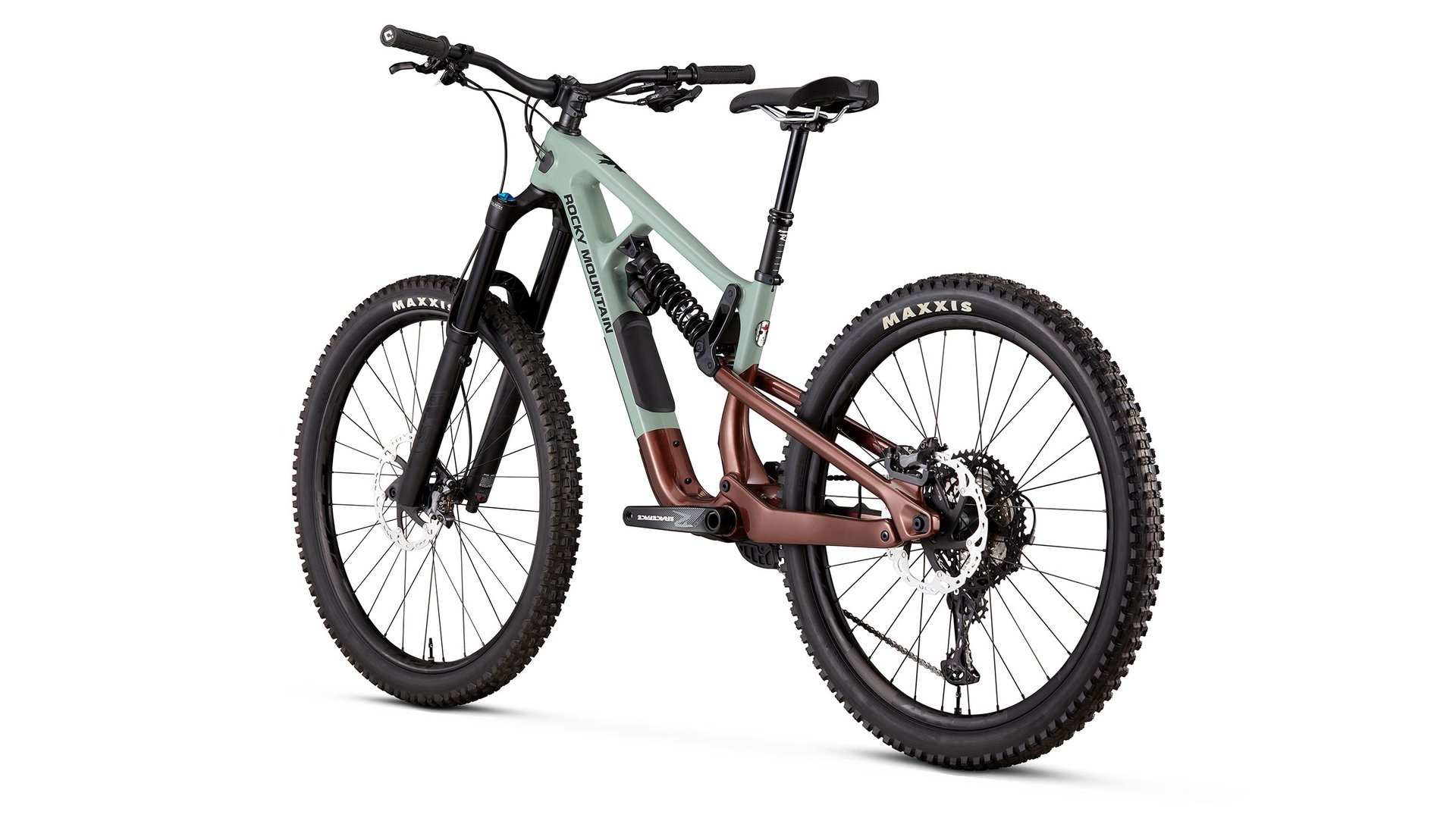
Slayer Carbon 70
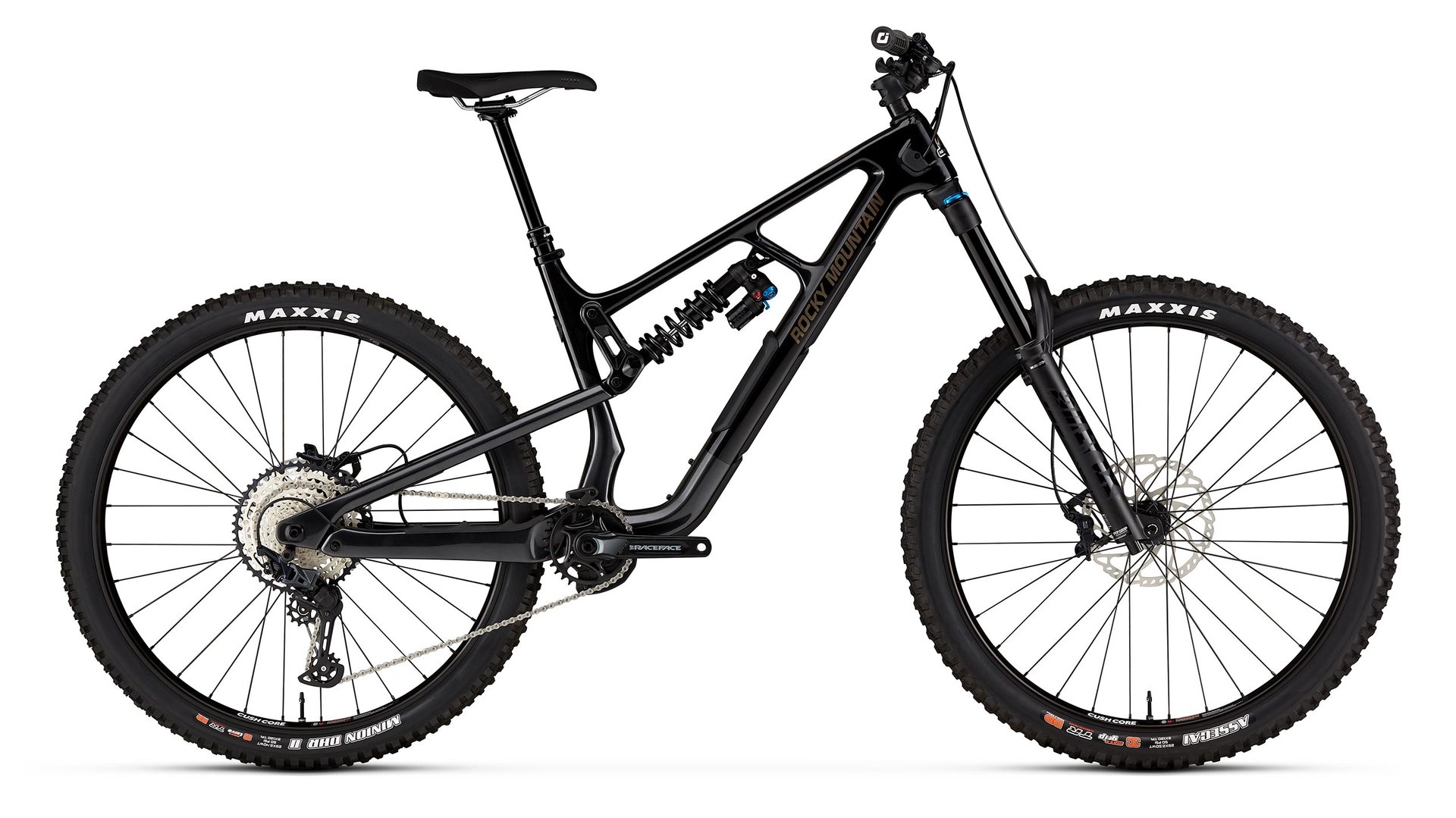
Slayer Carbon 50
Before I dig into the alloy models, I need to talk a bit about tires - specifically, I need to talk about how Rocky deserves a standing ovation for including proper tires on every Slayer model, all the way down the line. From the Carbon 90 all the way down to the Alloy 30, you get a Maxxis Assegai MaxxGrip DD up front, and a Minion DHR II MaxxTerra DD out back. If I were out shopping for Maxxis rubber, this is the exact combination I’d spend my money on. The lone exception is the park bike, in which case you get Maxxis Minion DH casings front and back, both in MaxxGrip compound. And while a MaxxGrip rear tire can likely measure its lifespan in minutes in the bike park*, it’s still great to see quality tires across the entire range.
*Pro tip: Save that MaxxGrip DHR II as a replacement front tire - they work great up there!
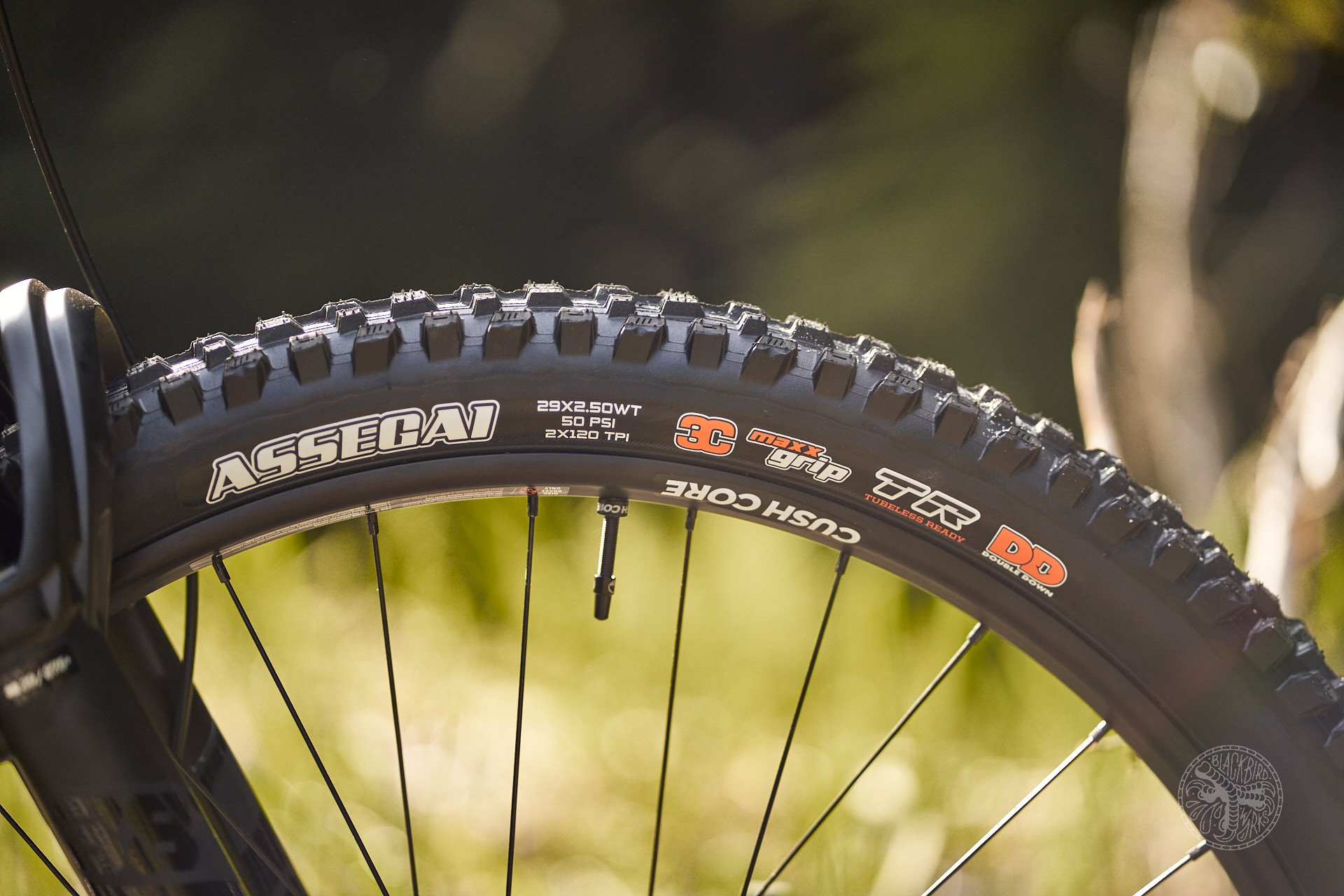
Every Slayer comes equipped with proper tires that you'll actually want to use. For their next trick, Rocky Mountain will develop a cure for cancer.
CushCore comes standard
Along with excellent tire spec, Rocky Mountain also ships every Carbon Slayer with CushCore XC tire inserts pre-installed. This is a very progressive move, and while it’s not totally new to Rocky (they already offer CushCore inserts as stock equipment on their Altitude Rally and Altitude PowerPlay models), I’m not aware of any other brand offering tubeless tire inserts as OEM equipment for mountain bikes. While I generally have nothing but praise for good tire inserts, I know a fair amount of very skilled and aggressive riders who don’t get along with them. I’ve also not yet tried Cush Core XC inserts, and while I understand they are much lighter than their Pro counterparts, if they don’t provide nearly the same support and protection, then Rocky has just given some riders an annoying chore to do (removing or replacing those inserts). Time on the bike will tell, and I’m cautiously optimistic that the DD tires along with XC inserts will strike a good balance between protection and weight.
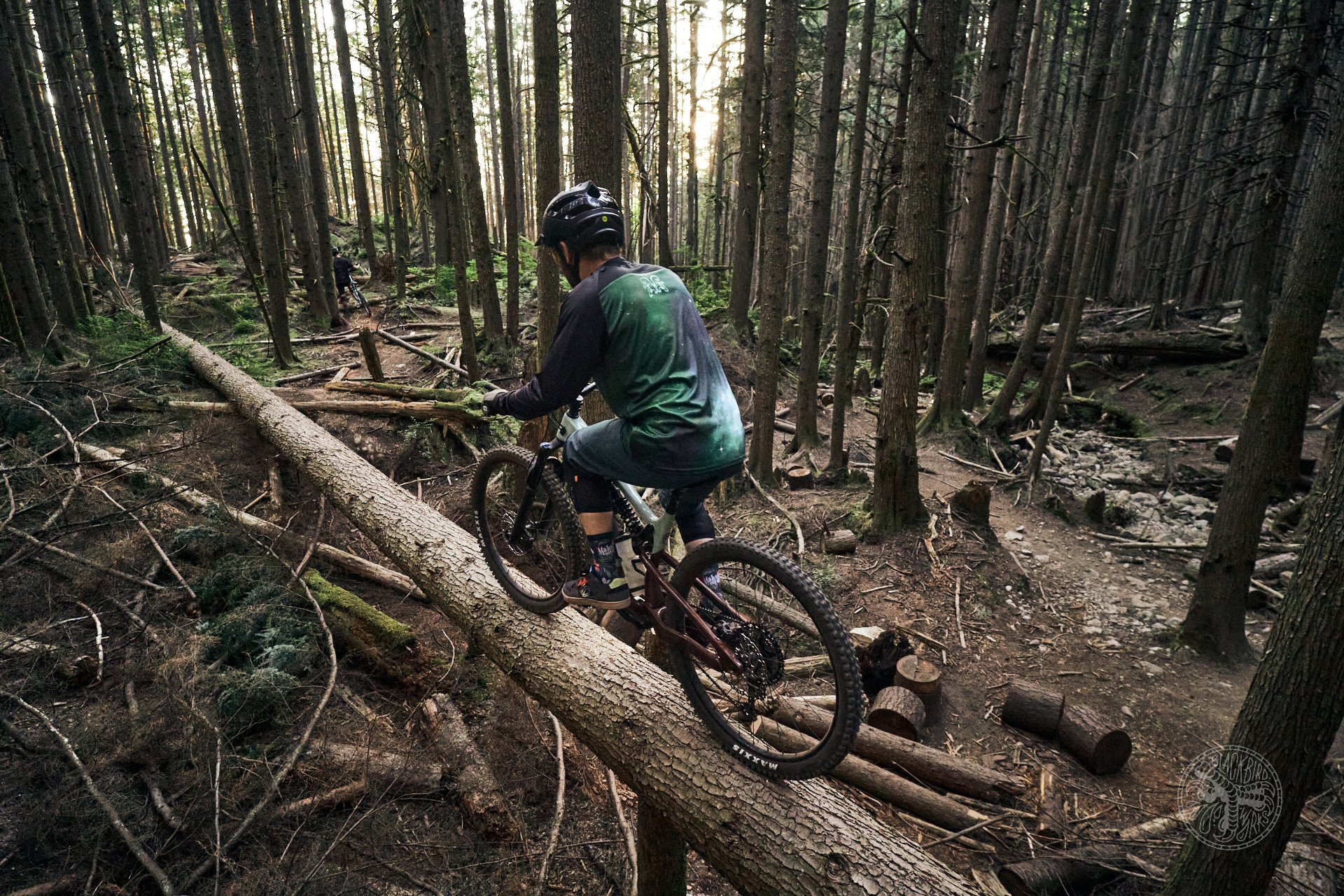
180mm travel 29ers can ride skinnies, as a treat.
Slayer Alloy Builds
At the top of the metal Slayers lies the Alloy 50, which sees a lot of the same parts as the Carbon 50, although RockShox steps in with a Zeb Select RC up front, and a Super Deluxe Coil Select+ out back. The Alloy 30 steps down to mostly Deore level kit, with a RockShox Domain RC fork and Marzocchi Bomber CR coil shock. Last but certainly not least, we have the Alloy 30 Park, which gets you a 200mm RockShox Boxxer up front, Race Face ARC HD rims, SRAM Guide brakes and a 7-speed SRAM GX DH drivetrain.
If none of the above tickle your fancy, build the bike of your dreams by starting with the Slayer Carbon Frameset, which ships with a Fox DHX2 Factory shock and OneUp chain guide and bash guard.
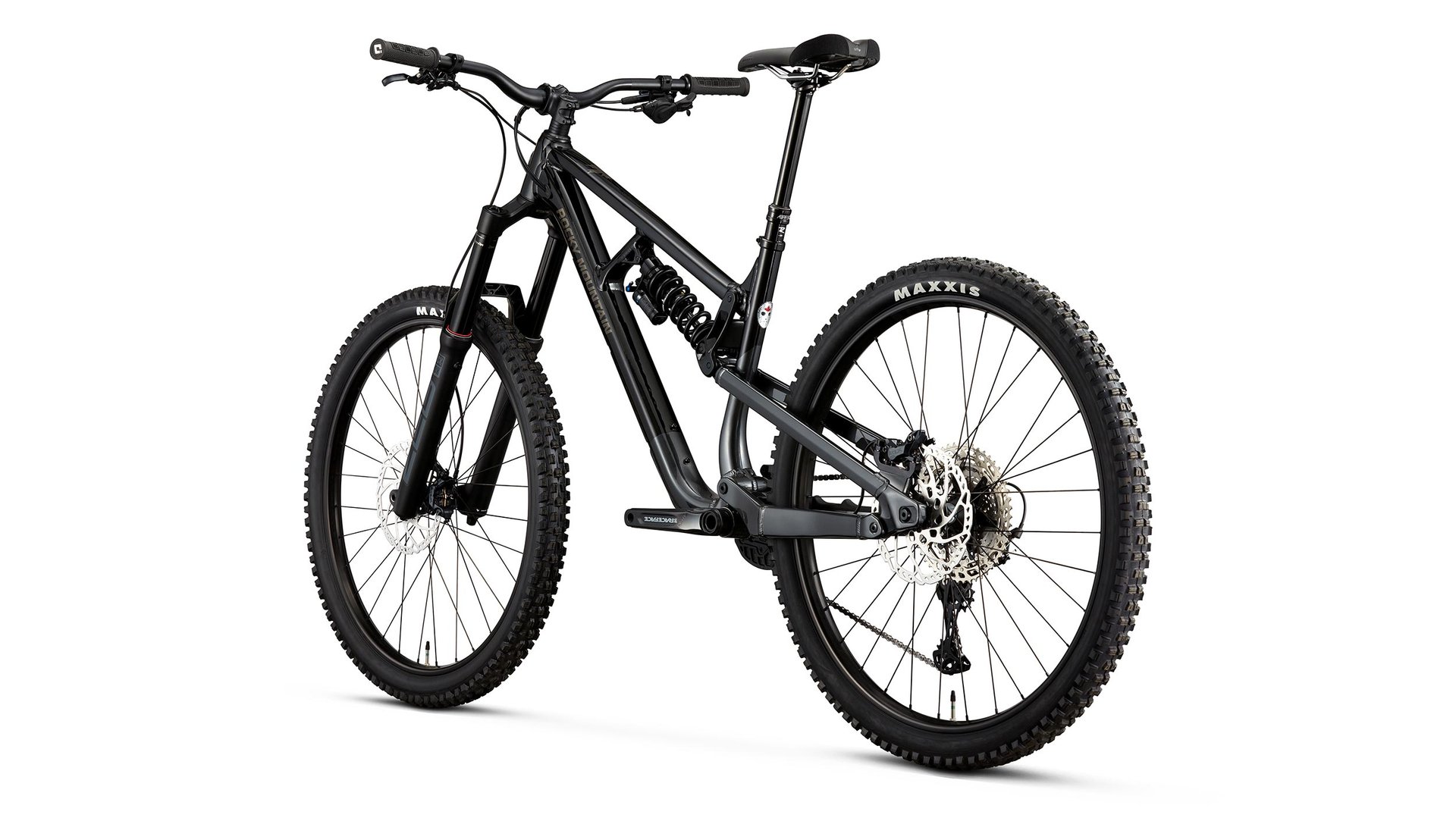
Slayer Alloy 50
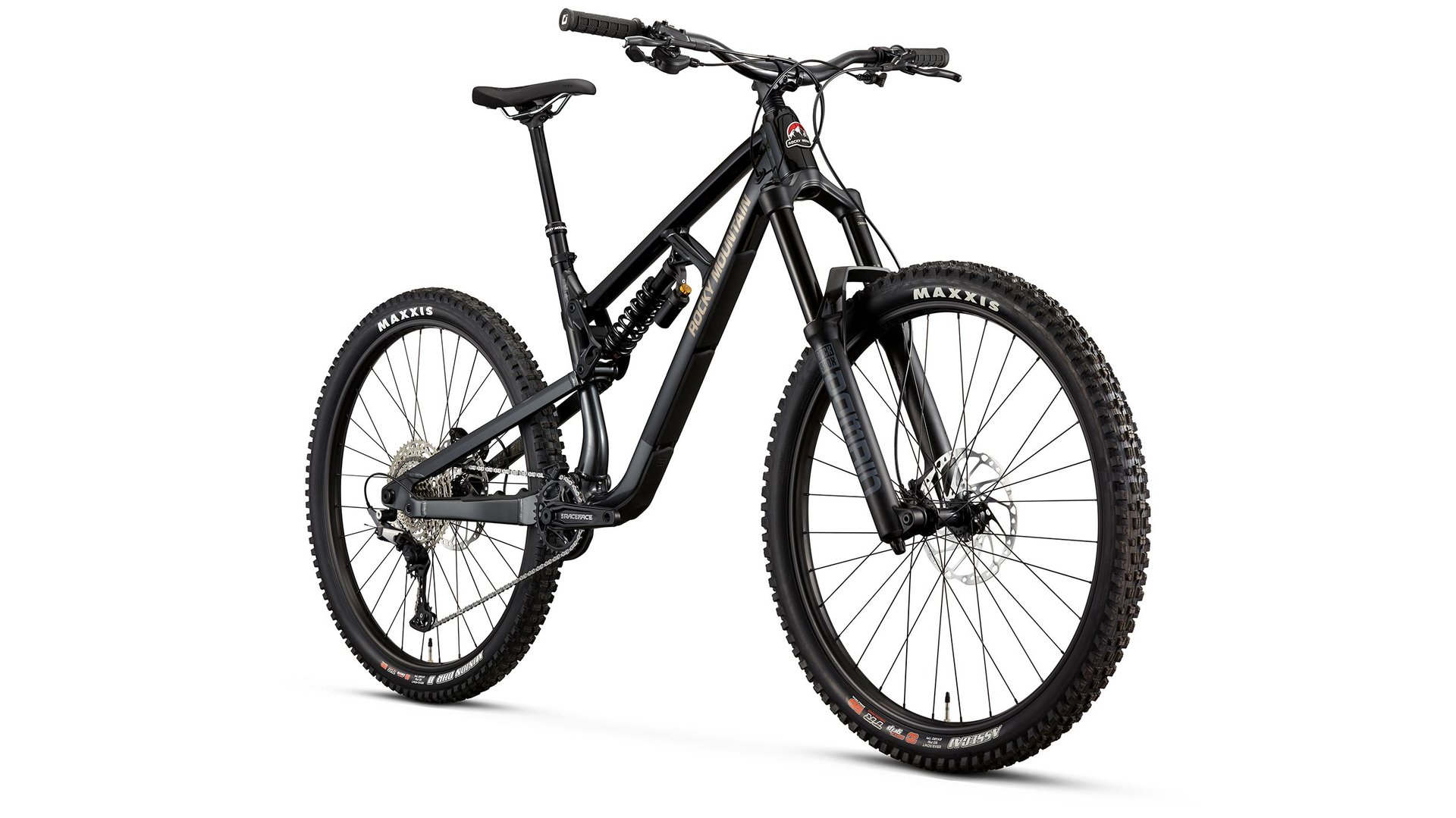
Slayer Alloy 30
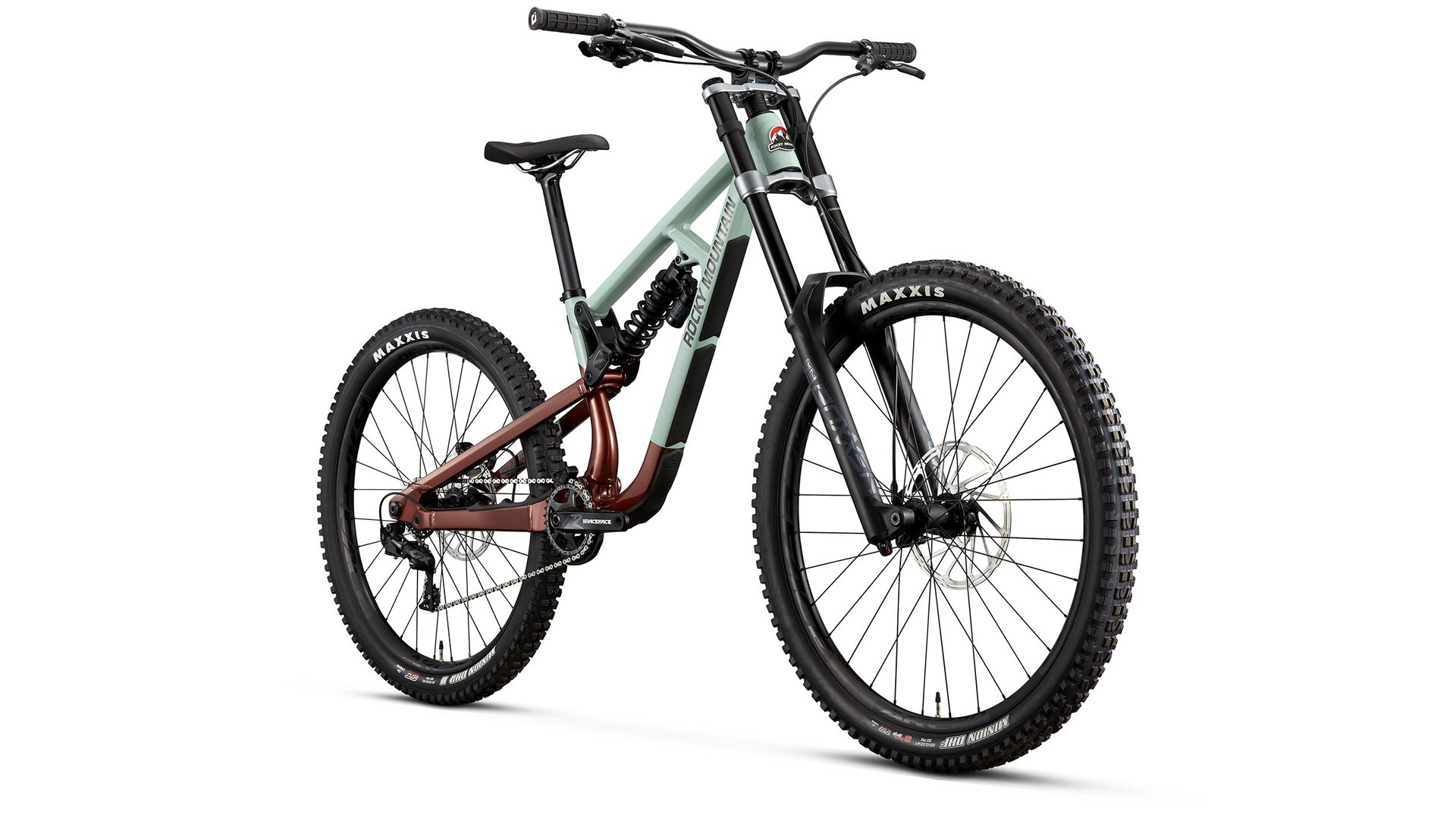
Slayer Alloy 30 Park
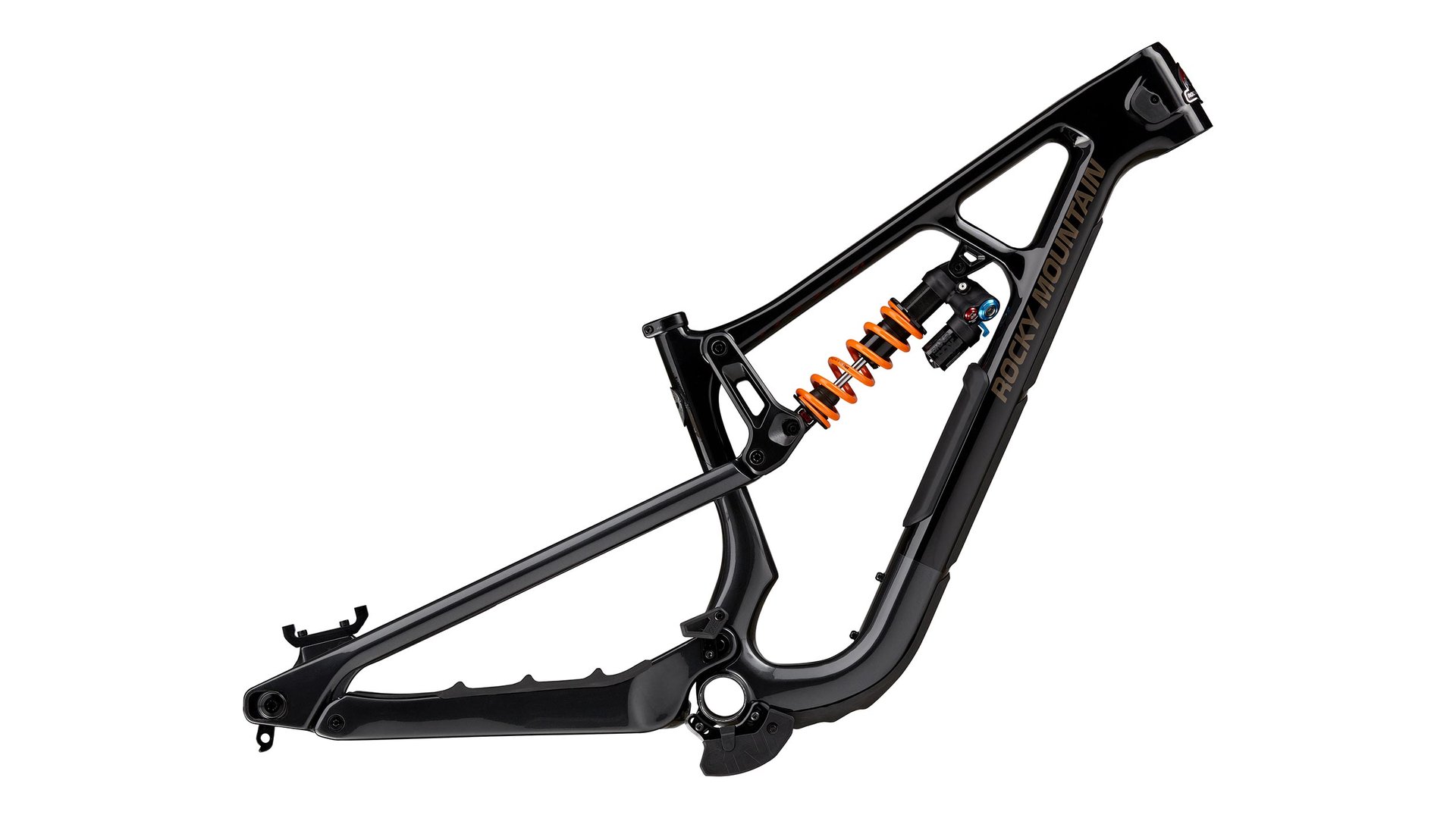
Slayer Carbon Frameset
Slayer Carbon 50 - First Riding Impressions
As this first look article goes live, I have had the Carbon 50 review bike less than a week, with only two rides under my belt. Even though we’ve barely gotten to know each other, there are a few things I can already share about the new Slayer.
While it shouldn’t come as a surprise to anyone, the Slayer is a bike that loves to eat, and if you can’t feed it a steady diet of turbo-gnar, it’s not the right dinner companion. Rocky markets the Slayer as a “freeride” or “big mountain” bike - the word “enduro” is nowhere to be seen in the press copy. Whereas some bikes in the 160mm travel range can feel sporty, the Slayer just wants to monster truck straight over everything - the faster, the better. To make it a better fit for tight and twisty North Shore singletrack, I’ve kept the chainstay length in the short position, while keeping the Ride-4 “neutral”. This makes for a bike that is plenty slack up front for charging the steeps, but still manageable when changing directions on janky, awkward corners. This geometry combo has been working very well so far, but I’m sure that the longer chainstay setting would be the ticket in the bike park.
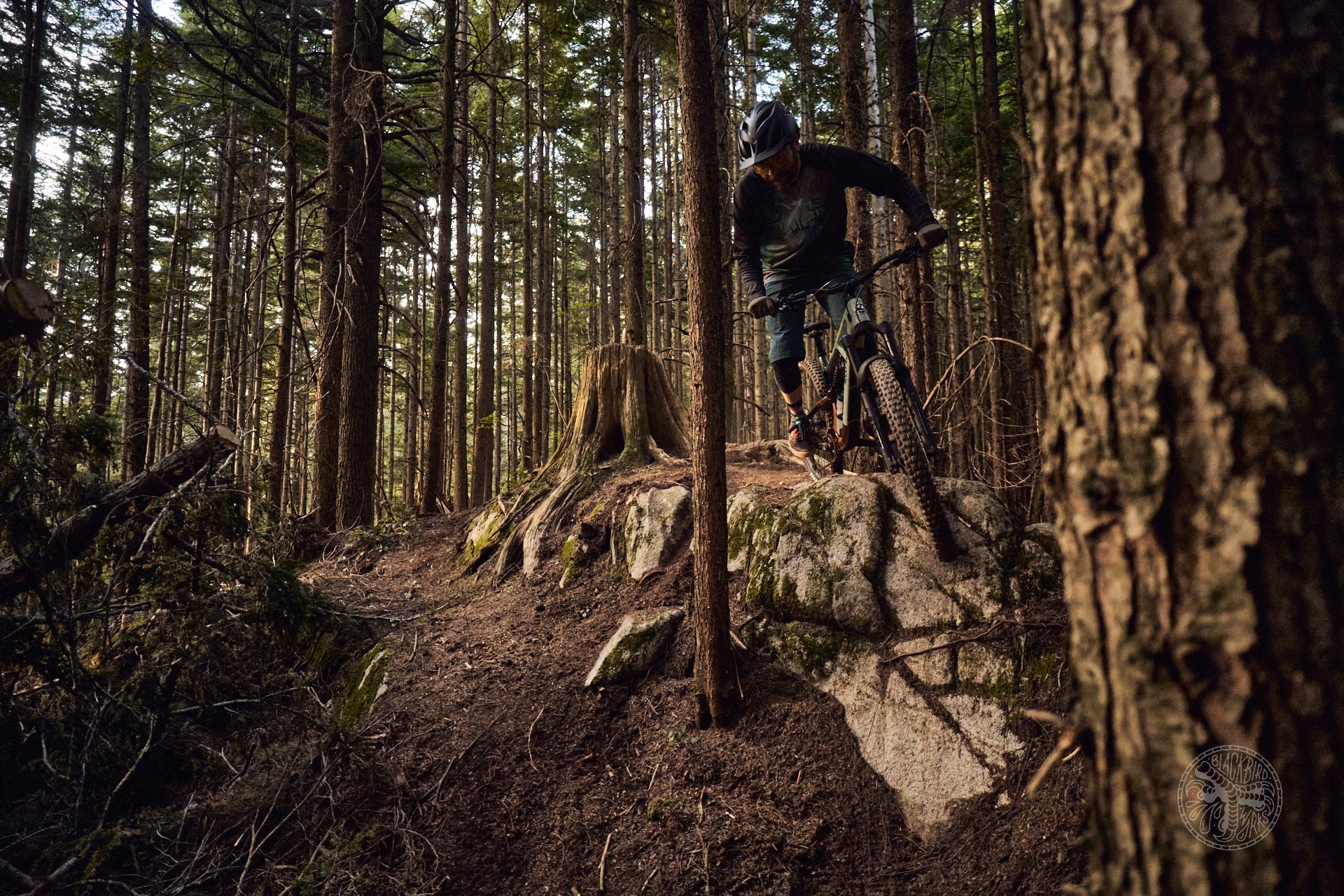
Horses for courses. The short chainstay setting helps this monster of a bike navigate awkward moves like this.
Suspension
While the Carbon 50 trim would not be my first pick if I were considering this bike, the mid-range parts hung on this frame reveal just how strong the Slayer’s bones are. Getting back to the Fox Performance suspension, while both ends pump out a whopping 180mm of travel, it’s clear from the get-go that both dampers are undergunned for the capabilities of this bike. They do the job, and will serve intermediate riders well, but they have a hard time keeping up with seriously aggressive riding - the very kind of riding the Slayer was designed for.
The large Carbon 50 comes stock with a 450-lb spring, which was far too soft for my weight and riding style. The 550-lb spring I threw on was worlds better, but resulted in me having to dial the rebound adjuster fully closed, and it’s still a bit too fast - keep this in mind if you are over 190 pounds and ride aggressively, you may find that the stock shock tune is too light. Rocky claims that: “Size Specific Tune ensures that riders of all sizes get the right balance of small-bump compliance, mid-stroke support, and end-stroke progressiveness. Our design team does custom shock tunes based on real world field testing, and adjusts each tune for specific frame sizes.” I’m perplexed by this statement, as I don’t think my 190 pounds is out of the ordinary for a size large, but I clearly fall outside the range of the stock rebound tune on the shock. Out of curiosity, I wound the rebound adjuster fully open, and found the return speed so fast, it would be unrideable even with a very light spring installed, so I’m not sure how Rocky arrived at this particular rebound tune.*
*One thing to keep in mind regarding the 550 lb spring, is that Ryan is a very hard riding lad. He uses more volume spacers in his fork than anyone we know and always seems to ride his suspension very firm indeed. - Ed.
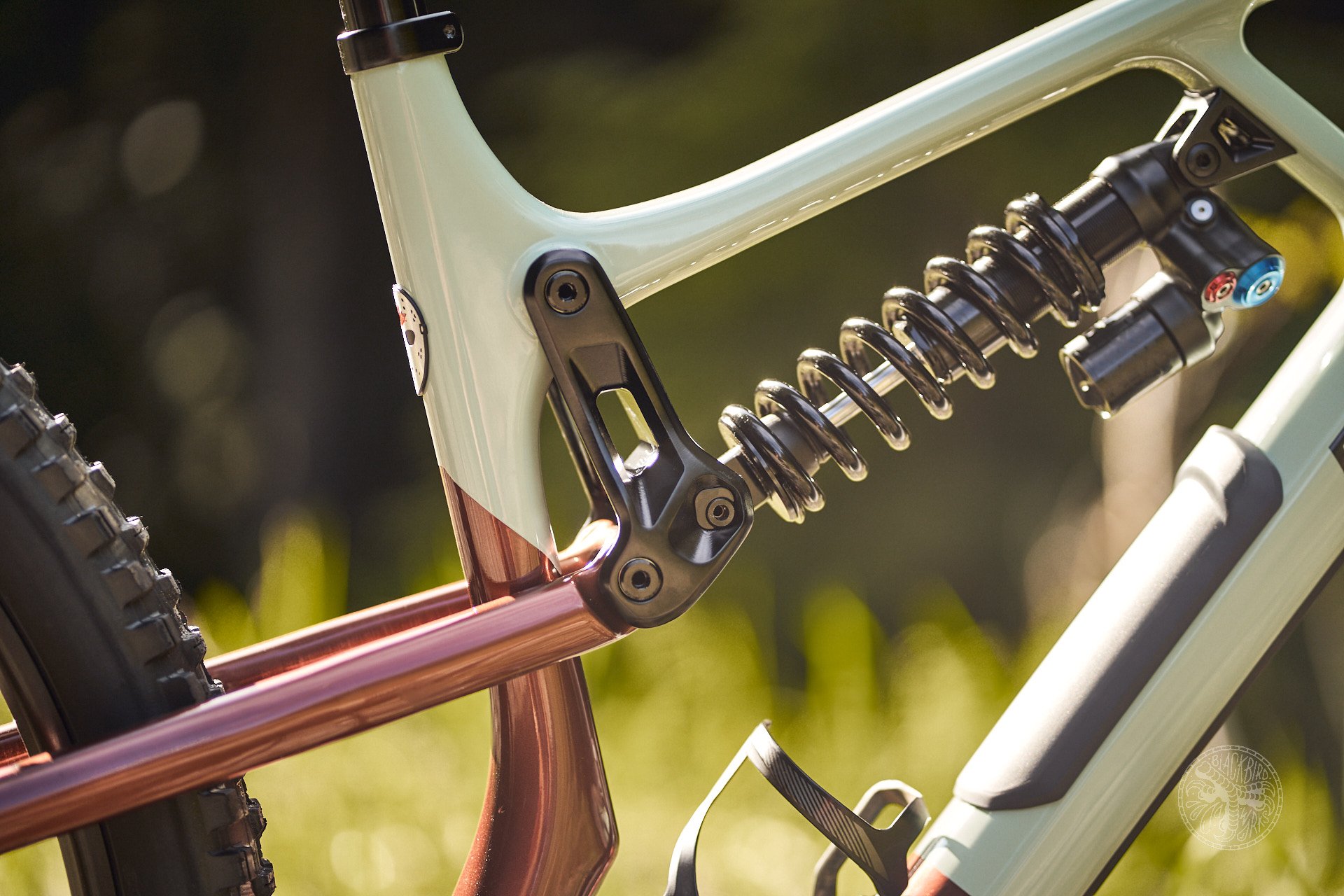
The stock DHX2 Performance Elite came undersprung and underdamped for my weight and riding style. In spite of this, the Slayer was still able to monster truck over all the things - a testament to this platform's capabilities.
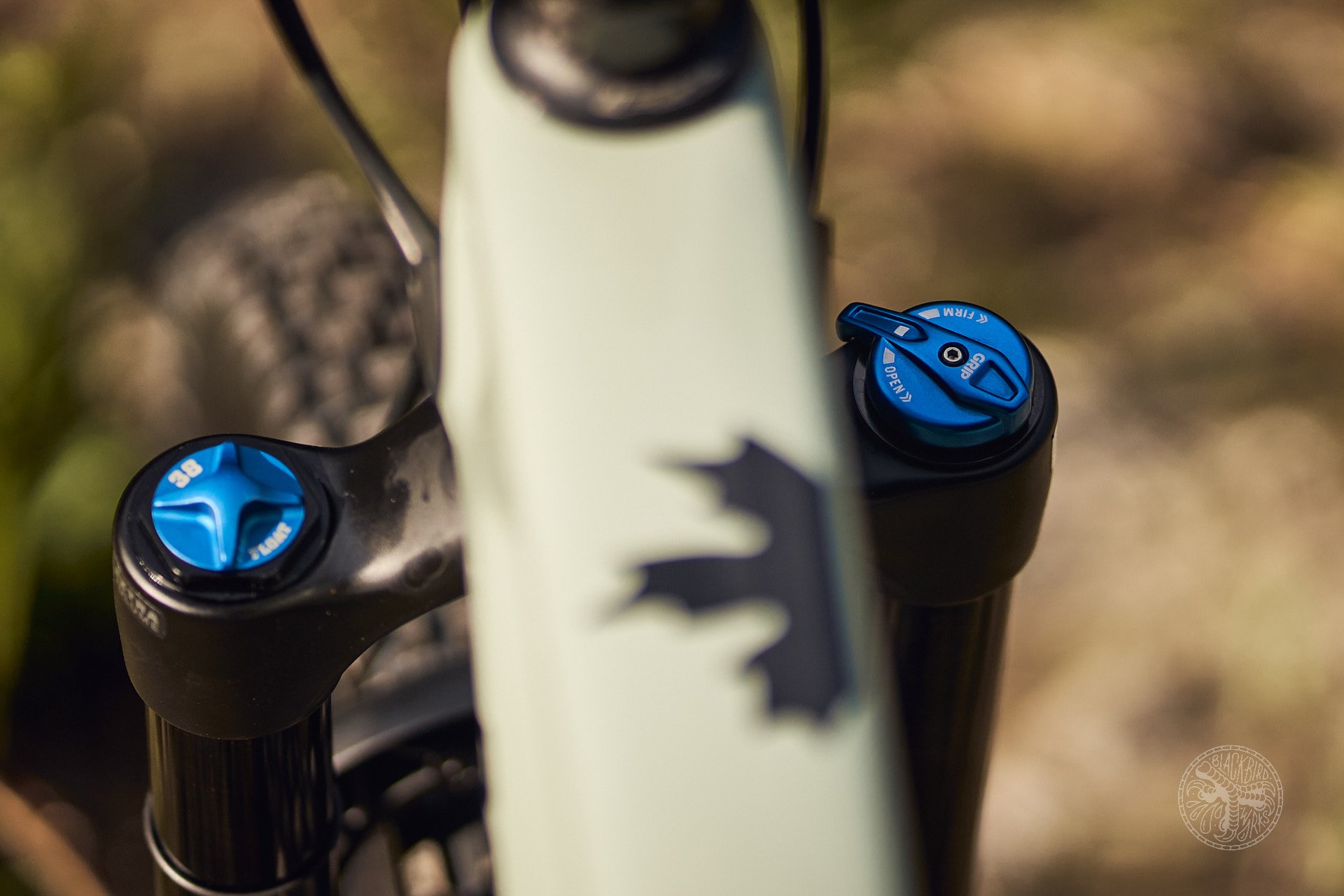
While not quite as confidence-inspiring as its GRIP2 cousin, the GRIP damper on the Fox 38 Performance fork gets the job done, and is actually quite capable if you let the air spring do most of the heavy lifting.
The fork has been a bit easier to get where I want it, but I’m still bracketing my pressure and volume spacer settings. The Fox 38’s GRIP damper is eager to get the fork moving, but the more sophisticated GRIP2 damper found on the higher trims has far more composure when things get hairy. Overall, I can already tell that the suspension will be the trickiest thing for me to figure out going forward. In spite of the suspension’s shortcomings, the Slayer’s geometry and kinematics have brought up the slack, and I can only imagine what the Carbon 90 must ride like…
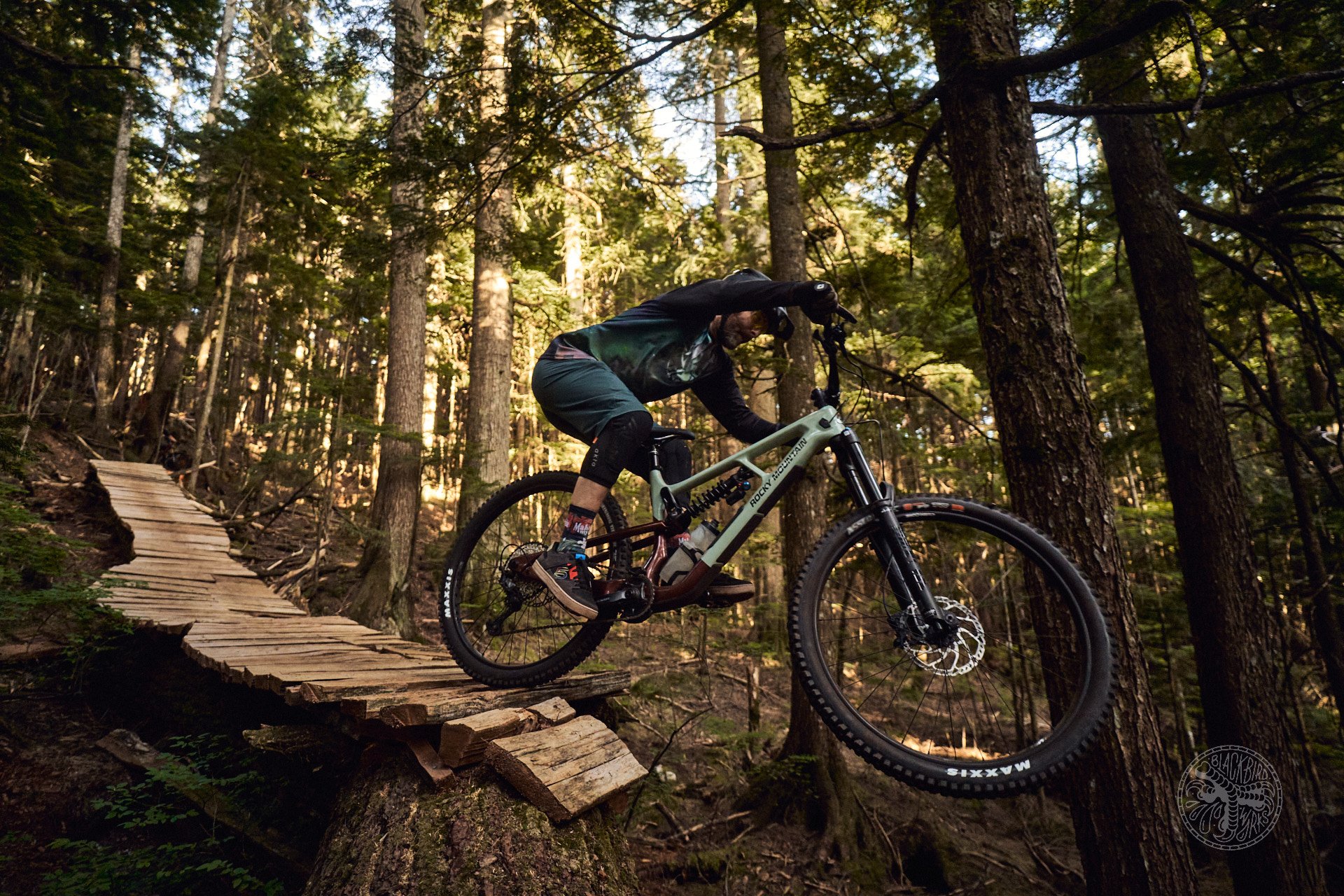
Classic Shore. If the Shore were sunny, hot, and dusty.
Shimano SLX Drivetrain & Brakes
The SLX drivetrain is functional, and has a very mechanical feel to it - even for Shimano. I can’t complain though because it hasn’t skipped a beat over the course of two rowdy rides. By far, the most pleasant surprise on this bike has been the 4-piston SLX brakes - with nothing fancy, and minimal adjustments, these brakes are just plain fantastic. Lever feel isn’t as tight and crisp as with higher-end Shimano units, and the pads rattle in the calipers (a common Shimano gripe that is not unique to SLX), but their power delivery and modulation have been excellent so far. There is a slight “buzzy” feedback that can be felt through the levers when braking, and I’m convinced this is caused by the rounded edges of the SLX rotor cutouts, but I don’t find it all that bothersome. Initially, I thought I’d be quick to swap out the 203mm front rotor for a 220mm, but now I’m not even sure I need to. And did I mention they’re very quiet?
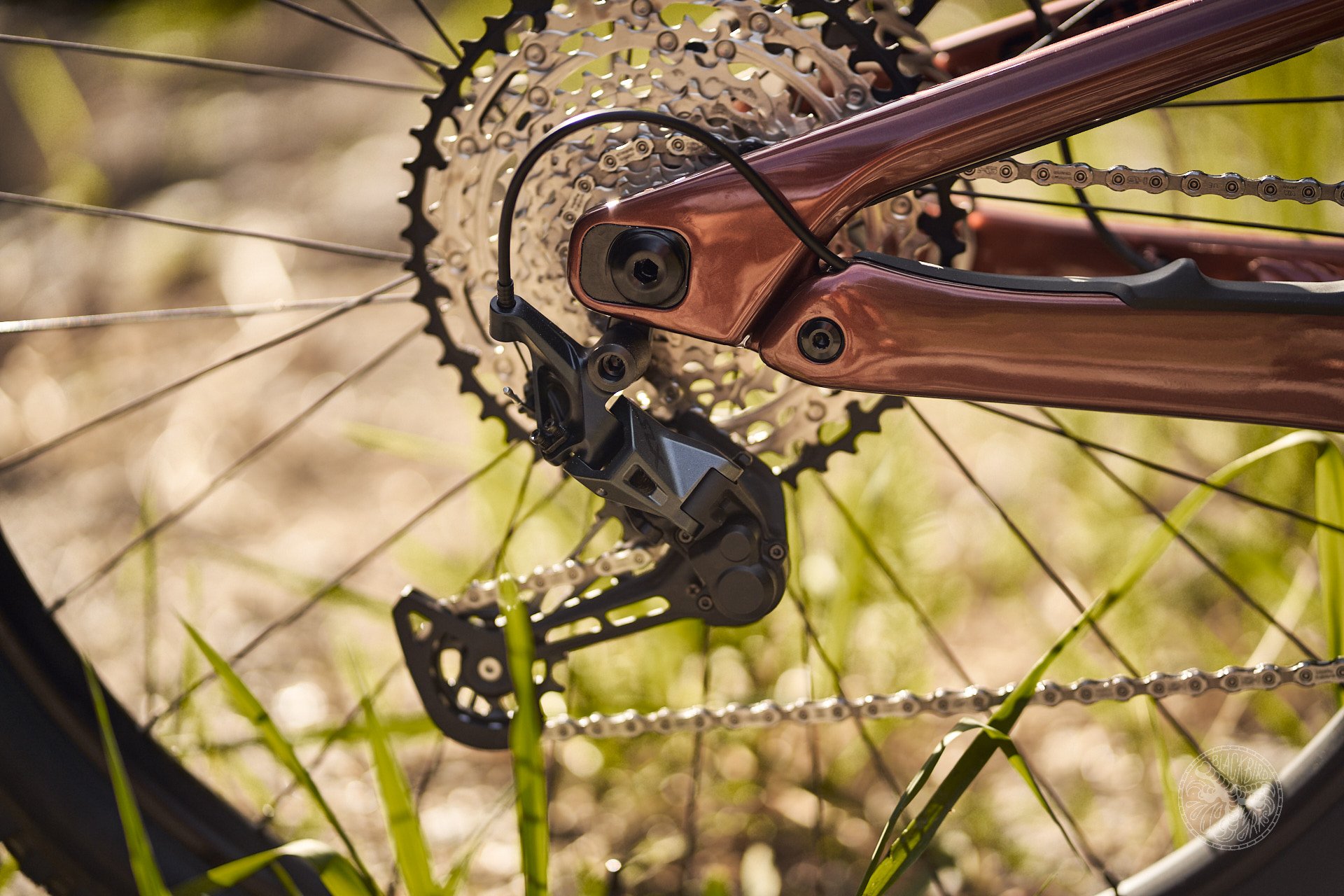
Pedalling is just a means to an end on the Slayer, and the SLX drivetrain is just fine.
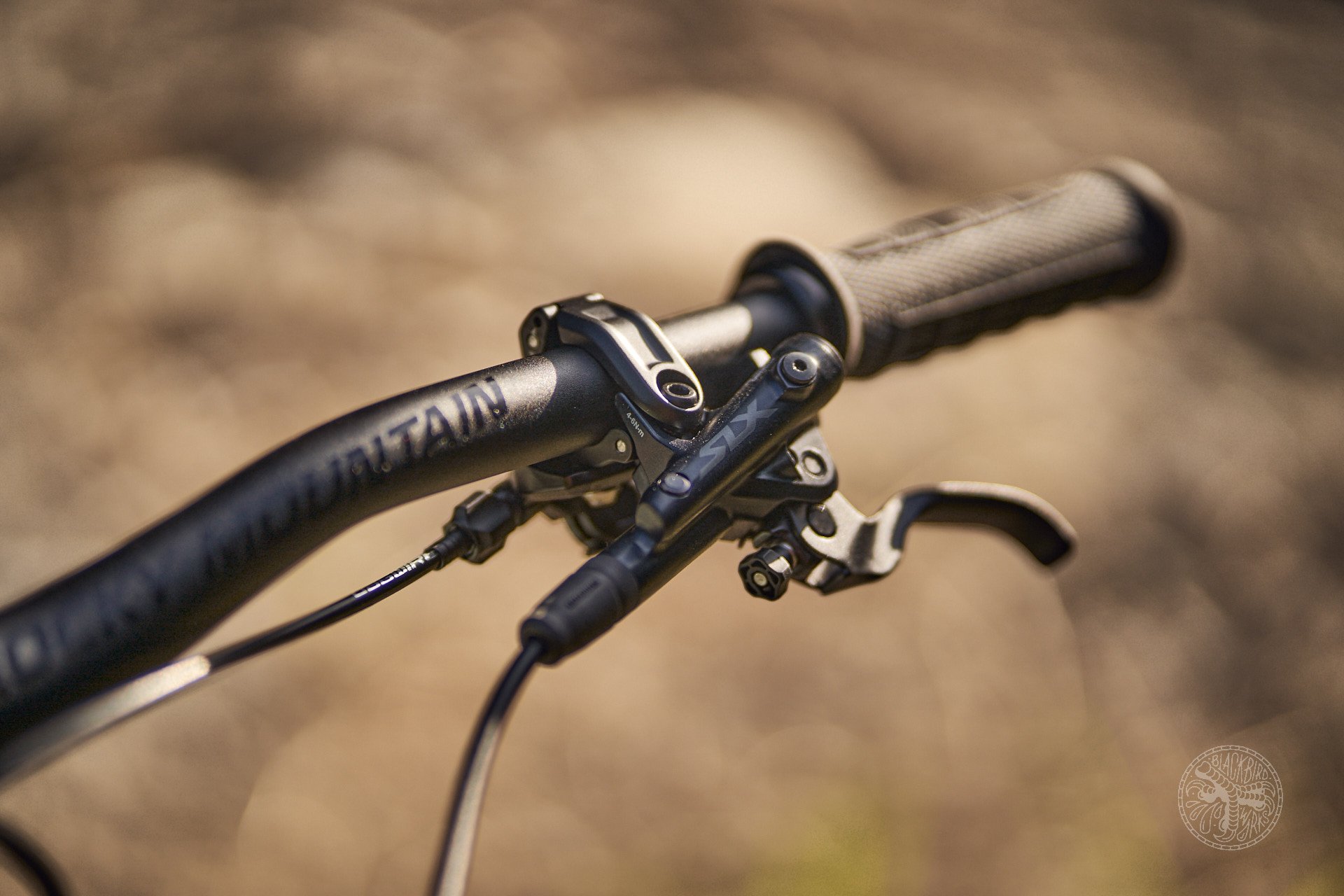
The 4-piston SLX brakes have been showstoppers. I'll see myself out...
Not much more I can say after my first week with the Slayer. I’m looking forward to really shaking this thing down over the summer, and finding out if the Carbon 50 spec can be considered a good value for the hard chargers out there. At the very least, the Slayer Carbon 50 can be viewed as a good starting point for aspiring freeriders, with a frame that seems well worth upgrading in the future.
Head to their site for more about the new Rocky Mountain Slayer.
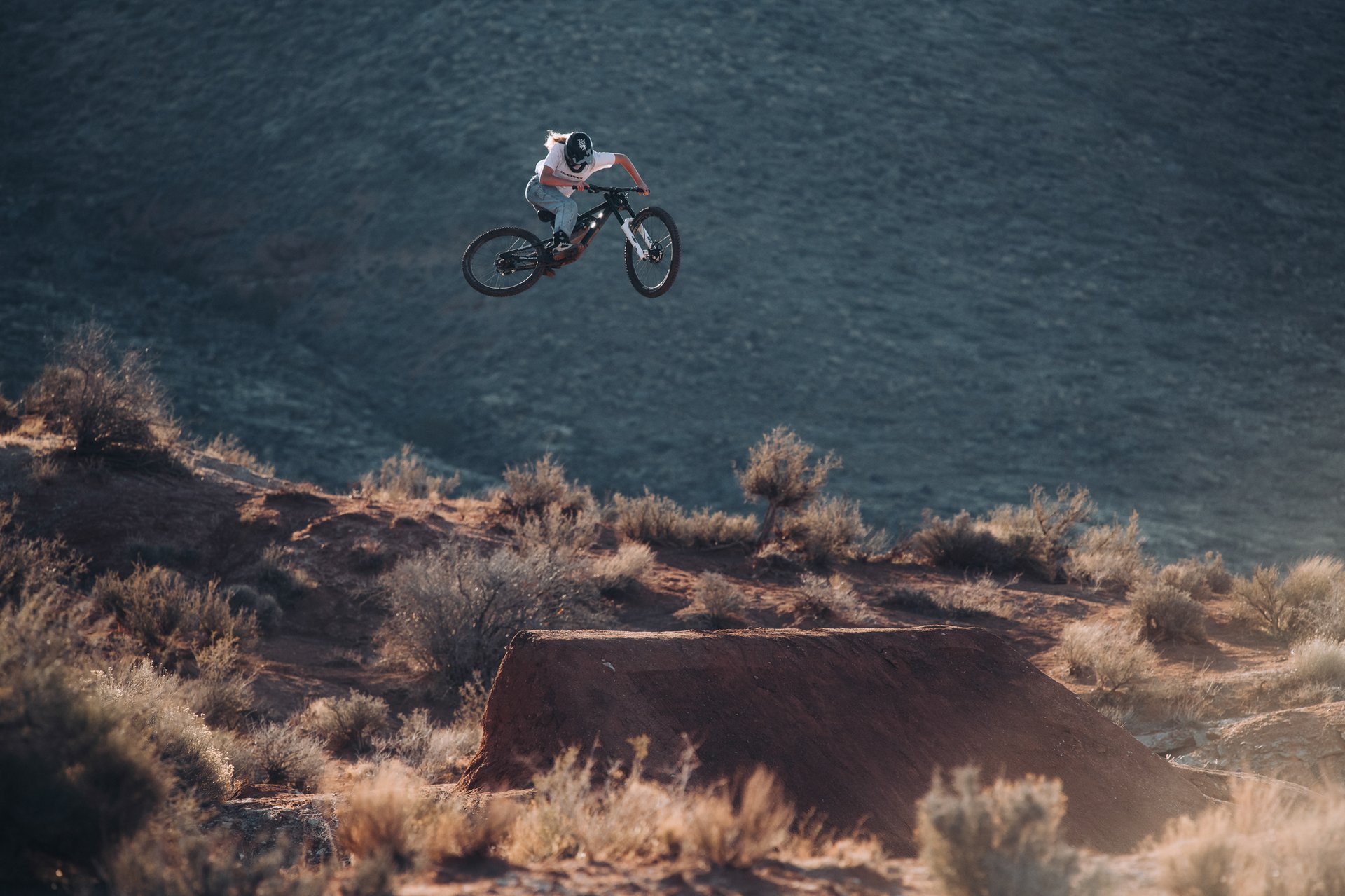
Lucy Van Eesteren blasting into orbit aboard her Slayer. Photo: Margus Riga
Rocky Mountain Slayer Pricing
Slayer Carbon 90 - 12,999 CAD / 10,299 USD
Slayer Carbon 70 - 9,699 CAD. / $7,799 USD
Slayer Carbon 50 - 7,799 CAD. / $6,299 USD
Slayer Alloy 50 - 6,199 CAD. / $4,999 USD
Slayer Alloy 30 -4,699 CAD. / $3,799 USD
Slayer Alloy 30 Park - 5,599 CAD. / $4,599 USD
Slayer Carbon Frameset - 5,499 CAD. / $4,199 USD
Age : 40
Height : 1803mm
Weight : 86kg
Ape Index : 1.03
Inseam : 787mm
Bar Width : 780mm
Preferred Reach : Pretty comfy at 487mm these days.

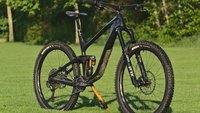









Comments
Kenneth Perras
10 months, 1 week ago
Just a bit of housekeeping since I'm part of the Slayer development team.
To address the spring rate issue: future Slayer productions will have their spring rates bumped up by 50#. Our agility to react to internal findings was seriously hampered by covid-supply chain and leadtime issues. We hope that customers can work with their RMB dealers to get a correct fit before leaving the store, a routine task with any coil spring spec.
Cushcore XC is used as a middle ground to protect the rims and offer a small amount of extra tire damping, rather than going with Cushcore Pro which goes a bit further by adding casing/sidewall stability. I felt that the DD casing tires already did the job when it came to casing stability, and the lower weight insert option was appealing to me since these bikes do get pedaled around.
On the topic of weight, I just want to point out that the carbon frame is only ~300g heavier than an carbon Altitude. A large carbon frameset with all hardware, protectors, and Fox DHX2 with 450# SLS spring (944g) is 3984g |8.78lbs. A perceived "heavy" complete build weight comes from using appropriate parts for the intended use and cost: DD tires, tire inserts, coil-sprung shock, etc.
Nice work on the log ride. Classic shore feature.
Reply
Ryan Walters
10 months, 1 week ago
Thanks Ken.
For the record, there was no sarcasm on my part regarding the weight of the build - just under 38lbs for a bike like this with DD tires, inserts, coil shock and SLX level parts is on par with anything else. For comparison, my Enduro with an all around lighter build is just under 37lbs.
While it's still early days in the review, I've already said to more than one person that I think I could see this bike as my daily driver with some different parts hung on it. That's as high praise as I can say for any bike.
Reply
Kenneth Perras
10 months, 1 week ago
Yep I realize that. Just getting ahead of the commenters that fixate on weight as a core problem.
For what it's worth, I've got my Slayer at 35lbs with a Float X2, 38, XT kit (and pedals!), RF Turbine wheels, DD tires with Cushcore XC, and a bit of bling with a Next R crankset and handlebar.
Reply
Tim Coleman
10 months, 1 week ago
Three cheers to Rocky for spec'ing appropriate tires and a coil shock on a bike of this intended use!
Reply
Pete Roggeman
10 months, 1 week ago
Thanks for popping in to add some detail, Ken! Always good to hear it right from the source.
Reply
Kenneth Perras
10 months, 1 week ago
No problem. Local news outlet and fellow dumpsterites after all!
Reply
handsomedan
10 months, 1 week ago
Wondering about min chainring size? Found max in the tech document, but no min.
Asking for a friend who hates 12 speed haha.
Reply
handsomedan
10 months, 1 week ago
Wow - quite the price jump from the alloy 50 to carbon 50 - $1600! I’m assuming rock shox vs fox performance is a wash.
Was hoping for something more like the trek fuel ex 8 to 9.7. Same build kit, but carbon vs aluminum frame for $550 difference.
What is the frame weight for the aluminum slayer?
Reply
Ryan Walters
10 months, 1 week ago
Interestingly, aside from suspension, the only major difference between C50 and A50 is that you get an XT derailleur on the A50, SLX on the C50.
Reply
Lee Lau
10 months, 1 week ago
Yes - beauty work on the log ride. Nice shots from Deniz
Reply
Perry Schebel
10 months, 1 week ago
nice work on that log ride.
Reply
Ryan Walters
10 months, 1 week ago
Short chainstays FTW!
Reply
Znarf
10 months, 1 week ago
Nice, informative article!
If you already don‘t feel jazzed about the suspension right now, wouldn‘t it be the right thing to have them re-shimmed or upgraded even for the review? The Carbon 50 isn‘t „affordable“ anyway. Most buyers in this price range will just upgrade, no? So it would be interesting to see what the frame is capable of…
Reply
Ryan Walters
10 months, 1 week ago
Agreed. Remember that I've only had the bike for a week - we'll definitely try to get things dialed in for the long term review.
Reply
Pete Roggeman
10 months, 1 week ago
As Ryan said, timing was tight. There's a lot to explore for Ryan with this bike, and a big part of the review process will obviously be spending time to explore the suspension tune and some options. Great news for all of you interested in this bike is that Ryan is a very good suspension tester, and also motivated to nail it, so you can expect that a good amount of detail and expertise will go into the full review.
Reply
Lynx .
10 months, 1 week ago
Nice initial thoughts Ryan, definitely not the type of bike or riding I'm into or looking at now, but very interesting none the less.
Cool of Ken to pop in and give a bit of his thoughts on the specs etc and really do appreciate the thoughts on the inserts. Never used inserts before, but now that there's the XC version with much more reasonable weight, am seriously thinking of giving them a go, despite never "needing" them just to see how or if they effect the ride quality/characteristics, especially in the rear of the Phantom.
Put me as another who absolutely agrees with Andrew on the dropping the groupo to Deore and putting the difference to better suspsneion, especially on a bike like this where pedaling is definitely more of a means to an end than on a trail or XC bike.
Reply
Ryan Walters
10 months, 1 week ago
While CushCore makes great products, I’d also recommend looking at Tannus Tubeless Armor, I run them on my own bike. They strike a pretty good balance of weight, protection and sidewall support. They’re also relatively inexpensive.
Reply
Gage Wright
10 months, 1 week ago
Hey Ryan, question. When playing around with ride 9, do you notice suspension kinematic changes e.g. less or more brake jack? This may be a monster truck either way so I assume you probably do not feel a lot of the braking forces.
re. weight
- People who buy this should be ok with the weight given the clearly stated intentions of this bike.
Reply
Ryan Walters
10 months, 1 week ago
Great question Gage! I haven’t yet played around with the Ride 4 (it’s only 4 on the Slayer). My first few rides have been in what Rocky calls “neutral” setting. While you do get small geometry changes with Ride4, I highly doubt any difference in braking will be detectable - the rear wheel axle path will be nearly identical for all 4 positions. I will definitely experiment after I get suspension dialed in.
I should add that the Slayer suspension feels great under hard braking, on par with any other Horst link bike I’ve ridden.
Fully agree on weight. When you throw in dropper posts and 12 spd drivetrains, bikes like this should be expected to weigh as much as a DH bike, maybe more. The new Slayer is totally in line with any other bike in this segment.
Reply
Gage Wright
10 months, 1 week ago
"It's a DH bike, I'm just happy I can pedal it up hills."
- voice of reason
I always thought ride9 was ride8 too many but I am looking forward to the reviews. Good work Ryan!
Reply
Velocipedestrian
10 months, 1 week ago
>Getting back to the Fox Performance suspension, while both ends pump out a whopping 180mm of travel, it’s clear from the get-go that both dampers are undergunned for the capabilities of this bike.
Isn't it a Performance Elite shock? I understand this is the same damper as the Factory model just without the Kashima, am I misinformed?
Reply
Ryan Walters
10 months, 1 week ago
That’s not the case anymore. Don’t quote me on this, but I think the new “Performance Elite” DHX2 shock is OEM only, and only has LSC and LSR adjustments.
Reply
Andrew Major
10 months, 1 week ago
This seems to be a missed opportunity to min-max a Deore drivetrain and four-piston brakes with better-quality suspension products. Maybe just too challenging for dealers to explain to customers.
----
Actually surprised there's not an alloy option with top-end suspension like the Altitude Alloy 70 Coil, which is one of the best values on the market for someone looking for high-performance suspension:
Fox Factory Suspension, DT Star-Ratchet rear hub, good tires, XT drivetrain & brakes w/ Aeffect R Cranks. Regular price 7K CAD (now 6300 CAD if they have your size). Just add CushCore.
Reply
Kenneth Perras
10 months, 1 week ago
100p agree with your take here. The Altitude Alloy 70 is the lesser known gem in our lineup, and a Slayer Alloy 70 has the possibility to achieve the same success.
Reply
Velocipedestrian
10 months, 1 week ago
Ooh, sneaky cheeky downgrade updates.
Reply
IslandLife
10 months, 1 week ago
I find the Cushcore XC addition puzzling for this kind of bike. I don't think CC-XC should come anywhere near a big "freeride" style bike.
I read Kenneth's explanation, but I had different experiences with cushcore XC. It definitely isn't a "middle ground" for a freeride bike. It's far too small to provide any extra support.. does give a small amount of damping. But it's so small and narrow that the little thin lip that does reach over the rim edge just gets cut to shit, and within a short period of time you basically have a useless hole filled weight in your tire. It only took me a couple days at a local bike park to pretty much destroy the rear one. Got a significant rim ding (from a not all that significant rock impact) and when I pulled it out, my rim had just been cutting right through the CC-XC.
CC-XC really is meant for aggressive XC-ish riding. The newer "Trail" version may have been a better "middle ground" choice. Or Tannus which is the same weight as XC but provides actual support and rim protection.
To Ryan's point... so many people also don't even use or want inserts that they probably should have lowered the price and left the insert choice up to the rider.
It's not something that would stop me from buying the bike, but I would definitely be pulling them out.
Reply
Kenneth Perras
10 months, 1 week ago
The newer CushCore Trail version didn't exist when the spec was chosen and frozen 2 years ago ;)
Good news is that the MY24s will come with Trail inserts which are much more suitable for this bike.
I did some extensive testing with XC and Pro inserts, with EXO+ and DD tires. I found both versions had their own advantages and disadvantages. The DD casings on the Slayer are doing most of the heavy lifting however, and the inserts are just an added level of insurance when using normal tire pressures.
Reply
IslandLife
10 months, 1 week ago
Thanks for the reply... always good to hear the rationale behind choices. I was thinking the trail version probably wasn't a thing when these decisions were being made. Which honestly, makes the choice of CC-XC for this bike even more puzzling to me!
Good to hear that the MY24's will get the trail version... haven't ridden them (enjoying my Tannus inserts too much to bother), but would suspect they're a more suitable choice.
Whatever choices you've made... you get respect for even thinking beyond the usual, spec'ing great tires and being brave enough to add inserts. Won't be for everyone, but the downside of just taking them out for those that don't want them, then maybe at least sell them... vs the upside for those that will love them... probably makes this a good choice overall.
Reply
Graham Mattingly
10 months, 1 week ago
This bike has me really excited to see what I'm assuming will be a forthcoming refreshed Altitude.
This is just barely too much bike for me and my terrain (Bellingham), but I'm guessing some geo updates and a Penalty Box will be on that imagined bike. All the details that I see here that I imagine translating over seem just perfect.
Kudos to Rocky on this one. Looks super clean and thoughtful. The tire with Cushcore XC spec has me curious. I'm on Cushcore Pros with EXO+ casings, and I'm going to run some numbers on the weight differential between that setup and this one.
Reply
MTB_THETOWN
10 months, 1 week ago
Can you confirm that the internal cables are push in one side, come put the other? I feel bait and switched on internal tubes being allegedly easier. Building up my friends smuggler, it had internal tubes that required taking the rear end off, park tool cable routing tool with magnets, and about an hour messing with picks to get the brake hose routed between the front and rear ends. My strong preference as a mechanic for internal cable routing is big ports at each end to make fishing out cables and adding foam padding easy and no internal guide tubes.
Reply
Ryan Walters
10 months, 1 week ago
At first glance, the routing looks to be legitimately guided all the way through - you can see the enclosed tubes when looking through the PenaltyBox. As far as how the entry/exit of the cables happens between the front and rear end, I will have a closer look and report back! I don't suspect that any funny business will be required for cable swaps - maybe the shock needs to be unbolted on one side to permit easier access to the entry/exit holes near the BB.
Edit: Confirmed - you will have to unbolt one end of the shock to rotate the swingarm enough to gain access to the cable ports near the BB shell. This is pretty common with internal cable routing.
Reply
MTB_THETOWN
10 months, 1 week ago
Thanks for checking. I still think that the guided internal tubes are more trouble than just bigger ports and some foam on the cables. I've also heard/read that it can create issues with getting proper compaction (probably wrong term) when the frame is being made.
The only exception to this is on my dads ti gravel bike there are tubes literally welded into the frame, which made that build nice and easy. Although that frame is just one piece unlike a full suspension mtb
Reply
Ryan Walters
10 months, 1 week ago
I've also heard the issue about internal cable routing affecting carbon compaction during the curing phase - sounds a bit like a red herring to me. Internal cable routing clearly adds complexity to the manufacturing process, and it's much easier to say that it affects frame strength than to actually add them in! Ha!
All routing is not created equal - the internal cable routing on my Specialized Enduro is a joy to work with. I've never had any issue with it, and removing and installing cables is a breeze.
Reply
Please log in to leave a comment.